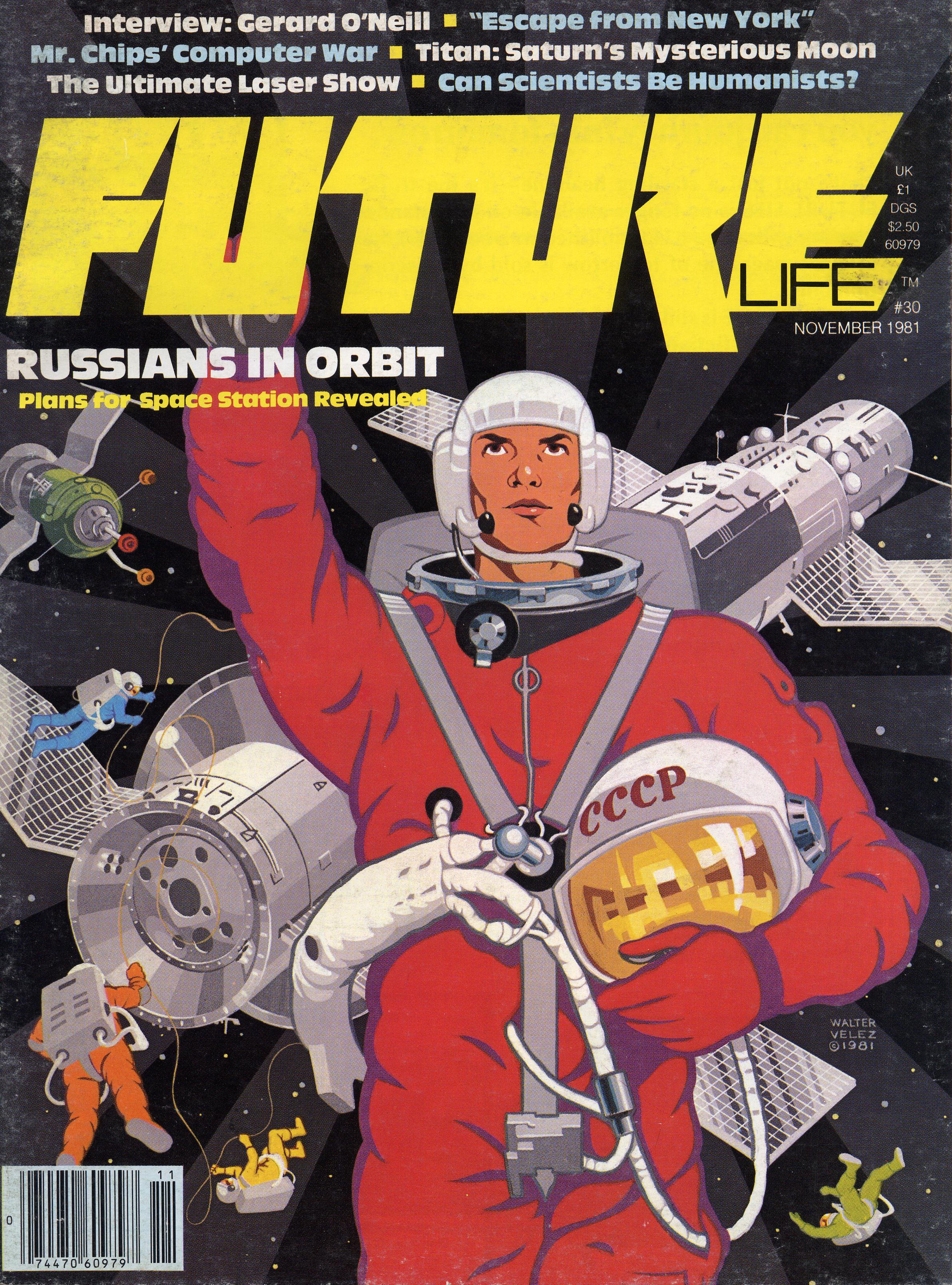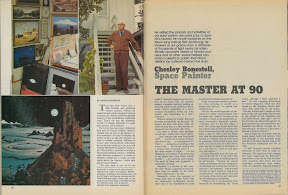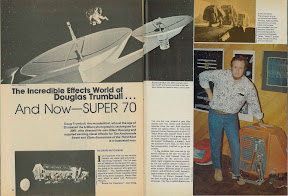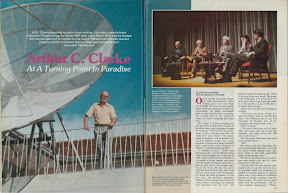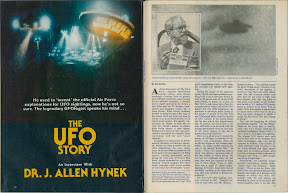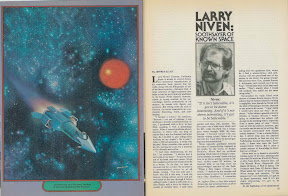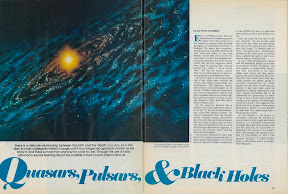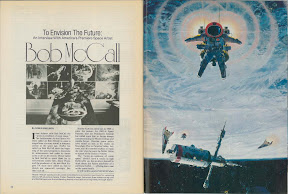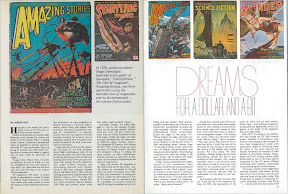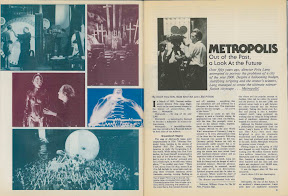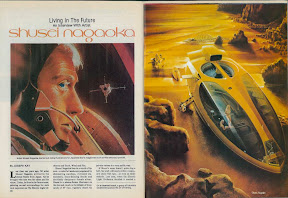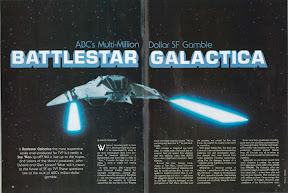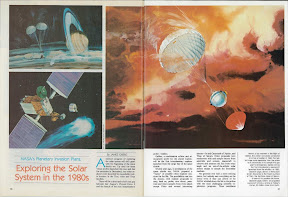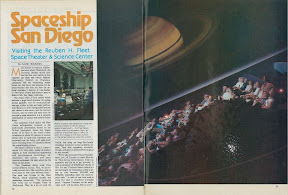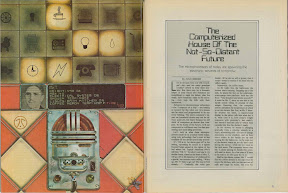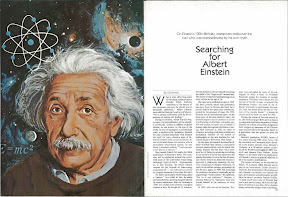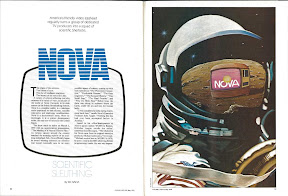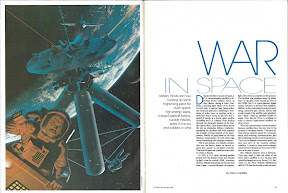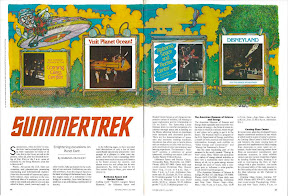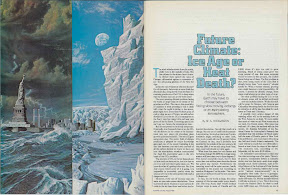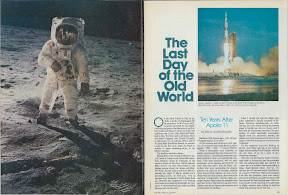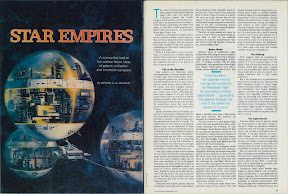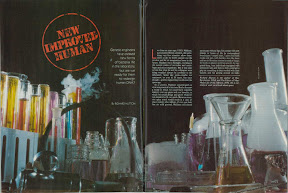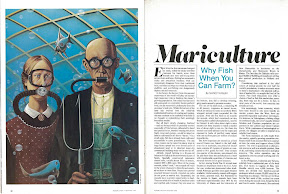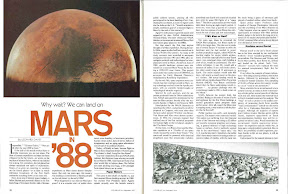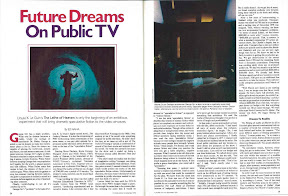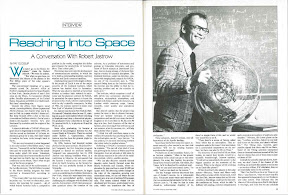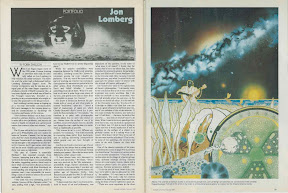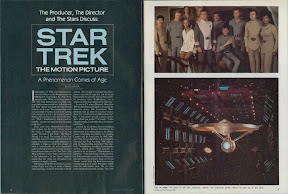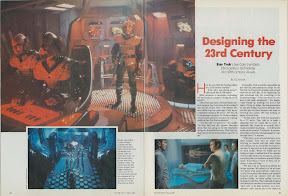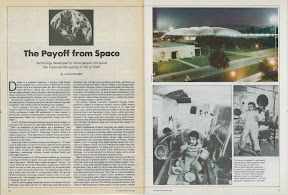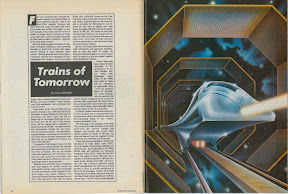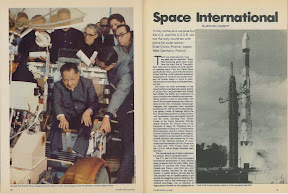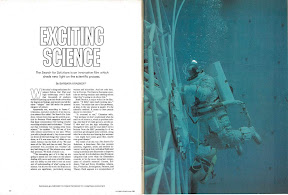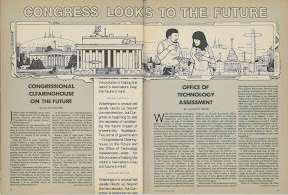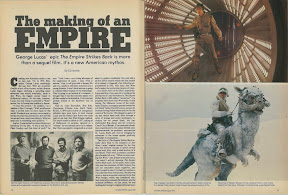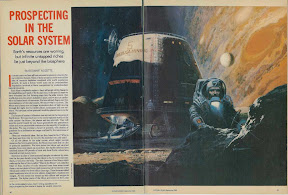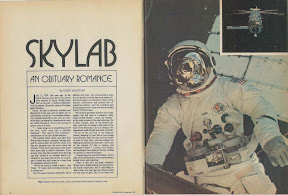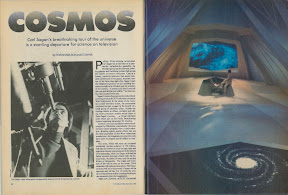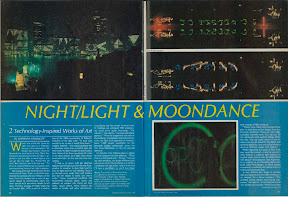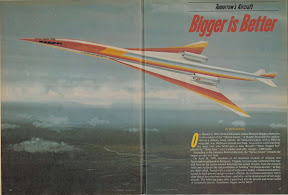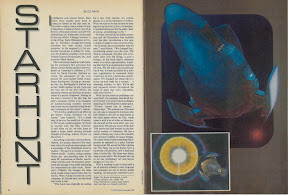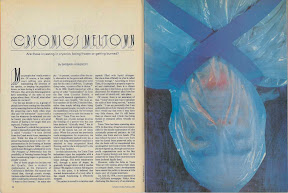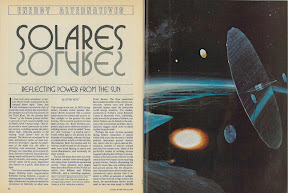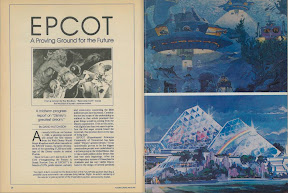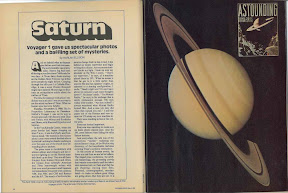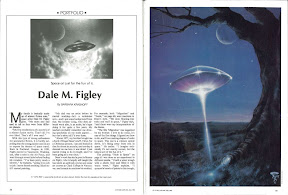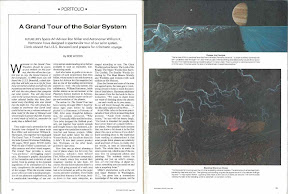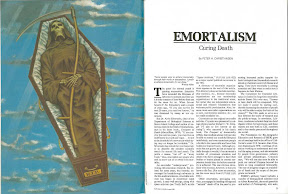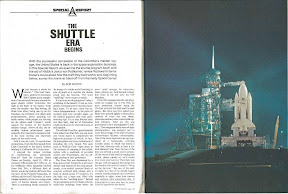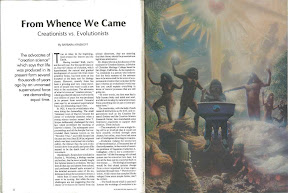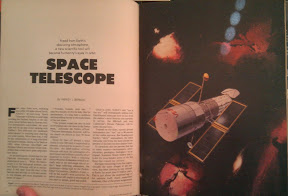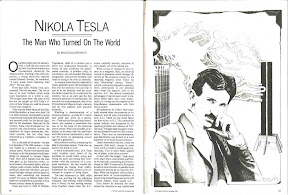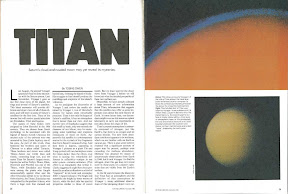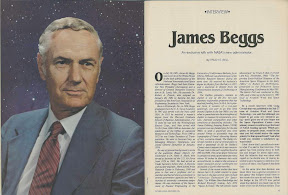| |
 |
FUTURE LIFE: THE
ENTIRE RUN |
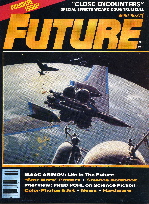
Future #1
80 pages (including covers)
Cover price: $1.75 |
Future #1, April 1978
The first issue of Future launches, produced by much the same staff as sister magazine Starlog. The staffs would slowly evolve apart somewhat, but for now, same publishers (Norman Jacobs, Kerry O'Quinn), same editor (Howard Zimmerman), same West Coast editor (David Houston), same art director (Howard Cruse), and many of the same writers. But who's complaining? It's a nice big enticing magazine.
In
this issue: The first six issues of Future would all feature a wrap-around cover, with no advertisement on the back cover. It looks great, and it helps showcase more articles inside the magazine, but I'm sure the publishers would have rather sold the premium back cover slot to an advertiser. The painting on the front cover of this premiere issue is by the great space artist Chesley Bonestell and originally appeared on the cover of the 1956 book Exploration of Mars, by Willy Ley and Wernher von Braun. Bonestell was a favorite of the staff of Future Life, and he would be featured in numerous interviews in Future and sister magazine Starlog over the years. In his inaugural Output editorial, Kerry O'Quinn argues that progress benefits
everyone; the letters section, called Input, includes well wishes from Neil Armstrong (yes, that Neil Armstrong) and Bonestell, as well as comments on Logan's Run, the origins of The Lord of the Rings, a possible Dune movie, and more; Databank is the name of the short-news section of Future, and it includes items on how a NASA space suit is helping an immuno-deficient boy live a more mobile life, news of sequels to Star Trek – The Motion Picture and Star Wars: A New Hope, the future of fast food, Harlan Ellison takes a stand for the Equal Rights Amendment at the 1978 Worldcon, an obituary for Dr. Peter Goldmark (inventor of the LP record), and more.
In the Video Images column, Ed Naha provides a roundup of the latest news on current and upcoming SF programs (Galactica, In the Days of the Comet, Project: UFO, Quark, and more); scientist Jesco von Puttkamer contributes a column, Science Notebook, on "Life
on Mars"; Ed Naha interviews SF author Fred Pohl; David Hutchison kicks off his Hardware section with a look at some new gadgets, including the Miniscope Model MS 15; Robert Skotak pens a retrospective of The Man
from Planet X; special effects artist Rick Baker showcases the making of the ape for the King Kong remake in a two-page photo essay; William J. Cromie reports on the health of the oceans; Civilization in Space is the magazine's serialized fictional look at the colonization of space, and associate editor Richard Meyers writes this first installment (with illustrations by Ron Miller); Scot Holton writes the SF Graphics column, focusing on the many different poster art approaches used to promote Star Wars; Future Forum asks various SF notables for their opinion on the question of the month: "What does the future hold for science fiction?"; David Hutchison interviews special effects genius Douglas Trumbull; In Print reviews the latest SF and nonfiction of interest, including Fred Pohl's Gateway, Paul Dickson's Out of This World: American Space Photography, and others; Charles Bogle (who is, I believe, a pseudonym for Ed Naha) looks at pedal-powered flight; Joseph Kay (who is not, as far as I know, pseudonymous) looks at the marketing of the animated film The Hobbit; David Houston extensively profiles master space artist Chesley Bonestell (illustrated with lots of his works in color and in black-and-white); in the Tomorrow guest columnist's slot, Isaac Asimov writes
about future society; and editor Howard Zimmerman's Perspectives column gives his thoughts on thinking big.
"I think that science fiction is the future. It's a literature of change. It talks about all the possible futures that may exist in one story or another. It will continue to do that indefinitely.As we discover new scientific concepts, SF writers will discover new ways in which they affect human beings."
–Frederick Pohl, writer, Future Forum
|
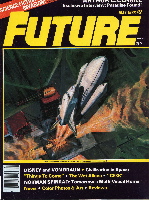
Future #2
80 pages (including covers)
Cover price: $1.75 |
Future #2, May 1978
This issue was produced with a mini-wrap-around on the cover to help spur newsstand sales. In stark red-and-white, it screams: "TOP SECRET: The Truth About ORBITING SOVIET BOMBS!"
In
this issue: The cover painting by an unnamed artist illustrates the future space shuttle launch, which wouldn't become reality for several years; in his Output column, Kerry O'Quinn writes about being thrilled by science;
Input letters include compliments for the magazine's first issue (from George Pal, Virginia Heinlein, wife of Robert, and others), and more; the Databank short-news section includes a report on the coming "Era of the Space Shuttle," wind power, NASA science helps cerebral palsy victims, and more; James Oberg explores the "space disaster" of Cosmos 954, the fallen Russian satellite; William H. Pratt previews the killer bees film The Swarm.
David Houston interviews Arthur C. Clarke; the Hardware page looks at Atari's music synchronizer, and more; Future Forum asks SF and futurist notables, "Should the future exploration of space rely on manned or unmanned probes?"; Scot Holton and Ed Naha provide a retrospective of The Shape
of Things to Come; In Print reviews books by Fred Hoyle and Frederic Golden; and in the SF Graphics column, Richard Meyers looks at science-fiction images in advertising.
Ed Naha compiles another roundup of SF TV programs for the Video Images column; David Houston and Richard Meyers pen this month's Civilizations in Space serial, "The Cola Wars"; Malcolm Brenner explores dolphin intelligence in "The Wet Aliens"; David R. Smith chronicles Disney's collaboration with Wernher von Braun; special effects artist Tom Burman shows the making of The Manitou in a two-page photo spread; Jesco von Puttkamer's Science Notebook focuses on the search for extraterrestrial life; Ed Naha interviews UFOlogist J. Allen Hynek; Norman Spinrad writes the Tomorrow column, focusing on "our multi-media future"; and editor Howard Zimmerman's Perspectives column looks at the state of the U.S. space agency.
"The men were fascinated with Willy Ley. Despite the odorous cigars that he chain-smoked, they gathered around him and hoped that some of his knowledge would rub off on them. ... Ley regaled the Disney men for hours on end with information about all aspects of space travel. He insisted that the planned flights could be done immediately, that no additional discoveries were needed, just money and motivation. Future discoveries would only make it easier."
–David R. Smith, writer: "They're Following Our Script: Walt Disney's Trip to Tomorrowland"
|
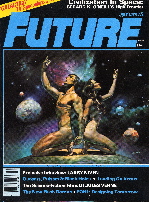
Future #3
80 pages (including covers)
Cover price: $1.75 |
Future #3, July 1978
With Gerard K. O'Neill's "High Frontier" concept and a report on the Otrag private spaceport project, this issue really exemplifies Future/Future Life's ahead-of-its-time devotion to moving into space. Think what it could do today, reporting on Virgin Galactic and the space programs of China and India.
In
this issue: The front cover painting, by Boris Vallejo, would cause some controversy, because some readers thought it was pornographic; Kerry O'Quinn's Output column is a short description of what type of magazine Future is; letter writers in Input praise and damn Harlan Ellison for making the ERA an issue in the science-fiction world, and more; short news in the Databank section includes reports on space-based solar power, biospace research, plans for a trans-continental super-fast railway across America, a Porsche-designed bicycle, and more.
David Houston previews the new animated Flash Gordon; James Oberg recounts the troubled life of Otrag, a German private
spaceport that was killed by Cold War politics and European rivalries; the Hardware page features new devices, such as the Microcepter, a nerve stimulator; David Houston looks at a Don Piccolo and Don Dixon short film about Venus, made for the Smithsonian; Jeffrey Elliot interviews SF writer Larry Niven; Ed Naha chronicles "The Films of Jules Verne"; Ed Naha's "The First One Hundred Years" continues the Civilization in Space serial; Future Forum asks some SF notables, "Is scientific accuracy essential for good science fiction?"; Ed Naha's Video Images column updates us on Battlestar Galactica, Nova, and more; Dietrick Thomsen explores "Quasars, Pulsars, & Black Holes"; In Print reviews Vonnegut in America, The View from Serendip, The Collapsing Universe: The Story of Black Holes, and more; Charles Bogle (remember, a likely pseudonym for former rock journalist Ed Naha) writes this issue's SF Graphics column, focusing on musician Lenny White's SF-themed album The Astral Pirates; Jesco von Puttkamer's Science Notebook looks at the "Quest Beyond the Stars: Are We Alone?"; Ed Naha and Richard Meyers profile fantasy artist Boris Vallejo, another favorite artist of publisher Kerry O'Quinn (and who would soon be illustrating an original children's book for Starlog/Future Life); Fred Pohl pens this month's Tomorrow column, "How to Invent the Future"; and Howard Zimmerman's Perspectives column comments on the pace of innovation;
plus news briefs, book reviews, and hardware previews.
"Assuming further that one million supercivilizations are randomly distributed in the Galaxy, there should be about 55 of them within 1000 [light years] from Earth. If all of them are radiating signals at us, we must investigate 40,000 stars to have a fair statistical chance of detecting a single extraterrestrial message – but the probability of being successful would still be only 63%."
–Jesco von Puttkamer, columnist, Science Notebook: "Quest Beyond the Stars: Are We Alone?"
|
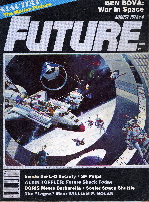
Future #4
80 pages (including covers)
Cover price: $1.75 |
Future #4, August 1978
A few notes of interest with this issue. First, the magazine has a new art director; Howard Cruse has moved on, though he would continue to contribute art to Future/Future Life, Starlog, Fangoria, and Comics Scene for years to come. Robert P. Ericksen, probably my favorite of the Starlog/Future Life art directors, takes over. Second, legendary editor and writer Ben Bova writes the Tomorrow column this month; Bova would also become an editor of competitor (and ultimate market victor) Omni magazine.
In
this issue: The cover painting is by Bob McCall. In his Output column, publisher Kerry O'Quinn talks about creative brilliance (and
brilliant creators); Input letters discuss modern music, UFOs, SF graphics, and more; short news in the Databank section include reports on a Soviet space shuttle (whatever happened to that?), NASA's "oblique-wing" aircraft, the new horror movie Martin (uh, why is this in Future?), the German synth rock band Kraftwerk, and more.
Future reprints from Parabola Magazine an article by Ursula K. LeGuin attacking Star Wars (and, all due respect to a great writer, she goes over the edge by comparing the movie to the Third Reich and gives the impression that she's off her meds); David Houston interviews author William F. Nolan; Jesco von Puttkamer's Science Notebook continues his look for intelligent life in the galaxy; James C. Odell looks at the Group I astronauts (Wally Schirra, Scott Carpenter, et.al.); Future Forum asks George Pal, Joanna Russ, Dr. Mark R. Chartrand, and other notables, "What is your favorite SF film, your least favorite – and why?" (don't know if Russ and LeGuin should have compared notes, but Russ compares the final scene of Star Wars to Leni Riefenstahl's Triumph of the Will, while LeGuin earlier compared it to Riefenstahl's Olympia – seriously, folks, even in free societies they hold awards ceremonies); Gerald Morris kicks off the magazine's coverage of the upcoming Star Trek film; Joseph Kay examines science fiction pulps; Civilization
in Space part IV: "The Great Rama Escapades and Centennial Celebration of the Arts," is written by David Houston; the Hardware page showcases a jet-powered flying platform; In Print reviews Bob Balaban's Close Encountersof the Third Kind Diary, Vonda McIntyre's Dreamsnake, and more; Ed Naha's Video Images department looks at the special effects of Battlestar Galactica (alternately known as Earth Star); Robin Snelson interviews L-5 Society founders Keith Henson and Carolyn Henson (the latter a future Future Life columnist); in the SF Graphics column, Richard Meyers looks at illustrated graphics; Ed Naha interviews the great Alvin Toffler ("After Future Shock"); Bob Woods (who would become editor of Future Life in a couple years) contributes "The Navy Drops a Boom Theory"; Robin Snelson (who would soon become Future Life's editor) profiles legendary space artist Bob McCall (illustrated with many of his wonderful paintings); Ben Bova writes this month's Tomorrow column, focusing on "The Military Presence in Space"; and editor Howard Zimmerman shares his observations about observatories.
"The end of Star Wars kept bothering me after I saw it the first time. ... Finally a friend who knows films explained to me that the scene is a nostalgic evocation or imitation of Leni Reifenstahl's famous film of the 1938 Olympics, the German winners receiving a grateful ovation from the Thousand Year Reich. Having dragged Dorothy and Toto and that lot around the cosmos a bit, Mr. Lucas cast about for another surefire golden oldie, and came up with Adolph Hitler."
–Ursula K. LeGuin, writer, "Noise and Meaning IN SF Films" (for the record, the Berlin Olympics were in 1936; Reifenstahl's film was released in 1938)
|
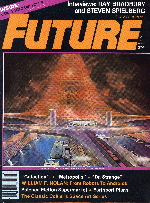
Future #5
80 pages (including covers and poster)
Cover price: $1.95 |
Future #5, October1978
This is one of the best issues of the early years of Future/Future Life, and it also has one of my favorite
covers, a painting by famed Japanese artist Shusei Nagaoka;
the cover painting is included as an oversize poster. Click here for giant-sized
cover image. A note: The cover price increases 20 cents with this issue. Also, for the first time, the contents page is designed to feature an image, in this case a giant painting of Icarus by David Hardy.
In
this issue: Kerry O'Quinn's Output column looks at revolting taxes; Input letters include feedback on the Lenny White album article, someone who thought Boris' cover painting for issue #3 was "trash" (it's worth noting that a Boris painting for an early issue of Starlog also led to readers accusing that magazine of pornography), a suggestion that the ERA doesn't belong in Future (in a letter written by Samuel James Maronie – is that the same Sam Maronie who became a prolific contributor to Starlog?), and more; Databank is filled with short news items on a future-oriented speakers bureau, cloning, a Things to Come remake, Future and Starlog translated into a Japanese edition, a North Pole trek, another article on Kraftwerk, SETI gets Sen. William Proxmire's Golden Fleece award, and more.
Robin Snelson reports on a proposed
international space port; Dr. Jeff Elliot interviews Ray Bradbury; Video Images updates the latest on SF and fantasy TV; a two-page photo feature looks at the aliens from Battlestar Galactica; Scot Holton, Bob Skotak and Lem Pitkin provide a retrospective of the great Fritz Lang German SF classic Metropolis; the Hardware column looks at a James Bond-like jet water bike; Joseph Kay interviews Japanese artist Shusei Nagaoka (and features lots of Nagaoka's color paintings); Jesco von Puttkamer's Science Notebook examines how up-and-coming civilizations would join the "galactic club"; Future Forum asks Marion Zimmer Bradley, David Gerrold, Joe W. Haldeman and others, "What will the next important breakthrough in the entertainment media be?"; Richard Meyers visits a science-fiction store in California; "Freeman's Rebellion" is the "Civilization in Space" serial episode contributed by Howard Zimmerman; Steve Swires interviews a Close Encounters-era Steven Spielberg; Louis Broadhurst looks at the musical version of War of the Worlds; In Print reviews James Naremore's The Magic World of Orson Wells, Glen Larson's and Robert Thurston's Battlestar Galactica novelization, Stanislaw Lem's The Star Diaries, and more; Ron Miller investigates Collier's classic 1951 space art series; William F. Nolan writes about robots and androids in the Tomorrow column; and Howard Zimmerman discusses making
positive change.
"Deeply [a]ffected by the post World War I atmosphere of Germany, Lang attempted to fit every philosophical trend of the times into his scenario. Following the financial ruin caused by the war, Germany quickly became not only an economically stable country but a visionary nation as well. Future-thought abounded and age-old concepts concerning the master race were mixed freely with hardware-oriented science and an expansive strain of economics."
–Scot Holton, Bob Skotak and Lem Pitkin, writers, "Metropolis: Out of the Past, a Look at the Future"
|
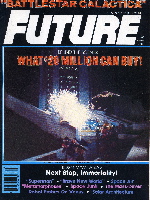
Future #6
80 pages (including covers)
Cover price: $1.95 |
Future #6, November 1978
Controversy is good for a magazine, and Future shows it's not afraid to court it. David Gerrold provides the fuel for his article on California's infamous anti-gay law. Of course, what should have been controversial is putting Battlestar Galactica on the cover.
In this issue: Chasing the Starlog crowd, Future for the first time features a cover photo from a TV or movie; in this case, the television blockbuster Battlestar Galactica. The two-page table of contents features a large space painting by artist Ron Miller. In his Output column, Kerry O'Quinn comments on David Gerrold's article on homosexuality; Input letters include a response to Ben Bova's Tomorrow column in issue #4 (along with a response from Bova himself), plus thoughts on the anti-Star Wars views of Joanna Russ and Ursula K. LeGuin, and more; Databank short news items (which now have bylines for the first time) include Bob Woods on the brown pelican vs. the space shuttle, Michael A.G. Michaud on a British plan for a robotic spaceship, Richard Meyers on NBC's The Clone Master, Ed Naha on British rock group UFO, Michaud again on the controversial moon treaty (an attempt to prevent private enterprise on the moon), and more.
Ed Naha interviews novelist Anne McCaffrey; Future Forum asks Gahan Wilson, Joanna Russ, Marion Zimmer Bradley and others, "What do you foresee as Earth's next great energy source?" (for the record, Gahan Wilson's response: "Slavery"); Robin Snelson explains the "mass driver" propulsion system; Richard Meyers interviews Christopher Reeve in a preview of the new Superman – The Movie; in "Sen. Briggs vs. SF Fandom," David Gerrold takes on a California politician who wants to ban books he deems gay-friendly (sound familiar?); in Ed Naha's Video Images column, he previews TV's Brave New World; Regina Baraban explores futuristic (and earthy) architectural designs; Syd Mead is featured in the magazine's first space art centerfold gallery; David Houston previews the new ABC series Battlestar the Galactica; In Print reviews Steven King's Night Shift, David Houston's Alien Perspective, G. Harry Stine's Shuttle into Space, and more; Richard Meyers looks at Frank Frazetta's art for a Jovan's Sex Appeal for Men Fragrance commercial; Meyers also talks with Takashi about his Metamorphosis film; Jesco von Puttkamer's Science Notebook explores Venus; Michael Dobson interviews artist (and Future advisor) Ron Miller and showcases some of his work; Richard Meyers – again – previews Amicus Productions' Warlords of Atlantis; Leonard David describes the dangers of space junk in orbit; Natalie Millar interviews writer John Brunner; a one-page Future Reader Questionnaire looks for data on readers (sign of the times: the top household income bracket listed is "$26,000 and over"); the Hardware page focuses on solar technology; Robert Anton Wilson's Tomorrow guest column explores immortality; and editor Howard Zimmerman's Perspectives column backs up O'Quinn and Gerrold in their opinions this issue, and also talks about human evolution.
"It was like a drug. I couldn't keep my hands off science fiction. And my husband, a Princeton English major, was having canaries about it. What was I doing reading this trash? Then I started to try to write science fiction. In 1954 I wrote a short story that Sam Moskowitz picked up for Science Fiction Plus. That was my first published story. What a thrill it was. I had a young baby at home, but this production was almost more important."
–Anne McCaffrey, writer, interviewed by Ed Naha: "Living with the Dragons: Anne McCaffrey"
|
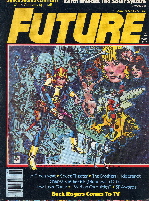
Future #7
80 pages (including covers)
Cover price: $1.95 |
Future #7, January 1979
This issue (and in an issue of Starlog published at the same time), Future announces a contest to design an experiment that will actually be taken aboard a flight of the space shuttle. The Getaway Special contest, which cost the publishers $10,000, would have its deadline extended at least once, and I never did see an announcement that a winner was chosen or that his/her experiment flew into space. But it's a good idea, at least; it is a concrete way to involve readers of these two ardently pro-space magazines directly in space activity, and it's also a contest that relies on mental success, not chance or brawn.
In
this issue: The cover features an illustration by Gil Kane from his Star Hawks comics series; the two-page table of contents image is a photo by Ctein of a rocket launch. Kerry O'Quinn on his Getaway Special contest; letters in Input defend artist Boris Vallejo, take a swipe at Sen. William Proxmire, and more; short news in the Databank section includes Michael Esteban on the making of Battlestar Galactica, William Pratt on some turtle-saving efforts, Ed Naha on how some Danish high schoolers are trying to revitalize the windmill, Robin Snelson on the return of Picturephone, and more.
Jeffrey Elliot and Al Flyn interview author A.E. Van Vogt; Steve Swires looks at the daily science-fiction comic strip Star Hawks; Bob MeCoy takes over the In Print column and kicks off his tenure by reviewing science-fiction illustrated books; Michael Cassutt provides a guide to various SF awards (Hugos, Nebulas, etc.); David Hutchison's Hardware page includes a little something called an Apple II computer (retailing for $970); James Oberg explains NASA's plans for exploring the solar system in the next decade; artist John Berkey's dramatic work is featured in the centerfold gallery; David Houston reports on "Realtime" laser games; Houston also interviews Buck Rogers in the 25th Century producer Leslie Stevens; Future Forum asks L. Sprague de Camp, Joanna Russ, Dr. Mark Chartrand, and other SF and science notables, "If you had a budget of $10 billion to develop any futuristic project ... what project would you choose?" (and Russ uses it as a platform to goad the Future staff over its alleged gender imbalance); the Video Images column looks at The Shape of Things to Come, The Martian Chronicles, and more; David Houston is earning his pay this month -- he visits the Reuben H. Fleet Space Theater and Science Center in San Diego; a two-page spread announces the Getaway Special contest; Bob Woods interviews the Brothers Hildebrandt; James von Puttkamer's Science Notebook continues his look at Venus; William Pratt reports on Weatherman; Carol Rosin gives career advice for people who want to work in space; Charles Sheffield looks at the role of private industry in space; and editor Howard Zimmerman's Perspectives column talks about a number of firsts in this issue of Future.
"A foundation to educate highly gifted kids, who are currently being ignored on the theory that 'they are getting along OK so they don't need help.' These kids are the ones who are going to build tomorrow's world and they are being turned off by education altogether while non-readers, mental defectives and the handicapped are being turned into part-readers, basic survivors and protected workshop successes."
–Marion Zimmer Bradley, author, Future Forum
|
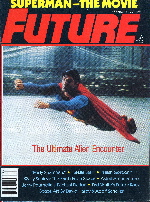
Future #8
80 pages (including covers)
Cover price: $1.95 |
Future #8, February 1979
Hmm, selling Superman – The Movie on the cover as "The Ultimate Alien Encounter" is a bit of a stretch. After all, people watch or read Superman for the superheroics, not any space opera elements. But you do what you have to do to sell magazines, I guess.
In
this issue: The two-page table of contents illustration is a painting by David Hardy depiction an Olympic games played on another planet. In his Output column, publisher Kerry O'Quinn discusses technological research and how inflation endangers it; Input letters include Harlan Ellison responding to criticism, many readers responding (pro and con) to David Gerrold's anti-discrimination article in issue #6, and more; in the Databank short-news section, Carolyn Henson writes about a possible Soviet rescue of Skylab, Richard Meyers on Arthur C. Clarke's newest works, William Pratt on a controversial claim to have invented a working robot, Michael A.G. Michaud on congressional hearings into the search for aliens, Starlog publishes its 200-page Space Art photo guidebook, and more.
After a two-page repeat of the Getaway Special contest rules, Jeff Elliot interviews scientist-turned-writer Jerry Pournelle ("From Space Science to Space Opera"); John Kepler explains the concept of a Dyson Sphere; Richard Meyers interviews director Phil Kaufman about his Invasion of the Body Snatchers remake; Ed Naha's Video Images column looks at Nova and a series of upcoming SF TV specials; Robin Snelson profiles private space company EarthSat (with a sidebar by David Houston on Wally Schirra); artist Adolf Schaller's work is featured in the centerfold gallery; Howard Zimmerman and Roscoe Pound preview Superman – The Movie (with a sidebar on how they made Supes fly); Michael Cassutt reports on the desert city Arcosanti; director Luigi Cozzi writes about his new movie, The Adventures of Stella Star; Future Forum asks Gahan Wilson, Bjo Trimble, Larry Niven, Gregory Benford, and others, "Do you think you'll have the opportunity to travel to space within your lifetime? Would you take advantage of it?"; Robin Snelson interviews artist David Hardy and features a portfolio of his paintings; Bob MeCoy's In Print column looks at computer books; the Hardware page features Maderna's underground swimming pods; Jesco von Puttkamer's Science Notebook looks at prospects for nuclear fusion; Ivan Berger examines "The Computerized House of the Not-so-Distant Future"; Ted White pens this month's Tomorrow column, focusing on rock music; and Howard Zimmerman compares and contrasts the state of our real space program with the health of fictional astronauts.
"When finished, fifteen or so years from now, Arcosanti will house five thousand people, all of them, in effect, living in a single huge building, with shops, schools, playgrounds and apartments all within walking distance of each other. No cars, no freeways, no smog. Arcosanti might just be the city of our future."
–Michael Cassutt, writer, "Arcosanti: A City of the Future".
|
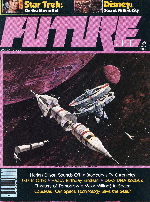
Future Life #9
72 pages (including covers)
Cover price: $2.25 |
Future
Life #9, March 1979
On its first anniversary, the magazine undergoes a name change to Future Life (why? not sure) and also reformats its insides a bit. Gone are eight pages, and all of the uncoated (non-glossy) black-and-white pages are upgraded to glossy pages, on which the magazine prints black-and-white plus one color. Also, the cover price jumps 30 cents to $2.25 (the second price increase in less than a year). Howard Zimmerman is no longer editor (though he remains editor of sister magazine Starlog); he is replaced at Future Life's helm by co-editors Ed Naha and Robin Snelson. L-5 Society chief Carolyn Henson joins the magazine as a regular columnist.
In this issue: The cover painting is by Vincent DeFate; Ron Miller provided the painting for the table of contents, which is now reduced to one page. In his Output column, Kerry O'Quinn says "the readership of Future has increased every issue this past year" and comments on his growing magazine; Input letters include Arthur C. Clarke saying hello from Sri Lanka, memories of astronauts, and more, including a letter from Patrick Daniel O'Neill defending Future's staff from Joanna Russ' charges of sexism (if I'm correct, this is the same Patrick Daniel O'Neill who became a writer and staffer at Starlog a few years later); short news in the Databank section includes Leonard David on Sen. (and former astronaut) Harrison Schmitt's space activities plan, Charles Bogle on a new automatic language translator, William Pratt on plans to haul an iceberg to the Middle East, Lou Stathis on musician Rupert Randall Chappelle, and more.
Robin Snelson reports on Disney's EPCOT community; Jeffrey Elliot interviews "science fiction's last angry man," Harlan Ellison; S.B. Bellows profiles the band Devo; Charle Bogle talks to Gene Roddenberry about "The Re-Making of Star Trek"; Carolyn Henson's New Space Program Notes column (the title would soon change) explains how to become a billionaire space business person; Bob MeCoy's In Print column looks at science books and science-based SF books; artist Ludek Pesek's work is featured in the centerfold gallery; Ed Naha celebrates Albert Einstein's 100th birthday; an unbylined Video Images article looks at The Martian Chronicles' upcoming TV mini-series; Philip L. Harrison looks at high-tech theaters; Future Forum asks Joanna Russ (because the editors are gluttons for punishment), Hal Clement, Joe Haldeman, and others, "Do you see a continuation of traditional sex roles during the next fifty years?"; Richard Meyers previews the James Bond film, Moonraker; Jesco von Puttkamer's Science Notebook examines the idea of terraforming; David Hutchison interviews artist Vincent DeFate and features a portfolio of his work; the Hardware page includes a Bang & Olufsen stereo receiver, and other gadgets; and in the Tomorrow guest column, Jacques-Yves Cousteau asks "Can Space Technology Save the Seas?"
"I don't use dope. I don't drink. I'm not into religion. I'm not interested in est. I'm a very pragmatic dude. For me, the act of creating, the act of building a dream, is the most exciting thing I could possibly do. Writing for me is a holy chore."
–Harlan Ellison, author, interviewed by Jeffrey Elliot.
|
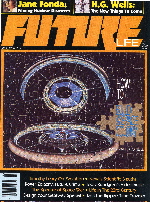
Future Life #10
72 pages (including covers)
Cover price: $2.25 |
Future Life #10, May 1979
If there's a (secular) patron saint of Future Life's early years, one of the contenders for the position would have been scientist Gerard K. O'Neill, who popularized the idea of building a functioning space station. He was sort-of interviewed as part of the Civilization in Space serial in the magazine's first year, but this is Future Life's opportunity to feature his work on the cover, front and center.
In this issue: The cover painting of a space station (divided into puzzle pieces) is by artist Don Davis; the contents page art is by Syd Mead. In his Output column, Kerry O'Quinn talks about living in the future today; Input letters include Arthur C. Clarke correcting an earlier article about him, pros and con about Harlan Ellison, praise from Chesley Bonestell for the magazine's new Space Art book, and more; the Databank short-news section includes Ed Naha previewing Meteor, Robin Snelson on predictions for Skylab's death, Leonard David on plans for a passenger shuttle from Rockwell International, Allan Maurer on worries about the ozone layer, and more.
Nancy Naglin previews China Syndrome; Stella Morris evaluates the possibilities of war in space; Joseph Kay looks at the new H.G. Wells adaptation The Shape of Things to Come; Barbara Lewis does the same for the H.G. Wells-themed Time After Time; Robin Snelson interviews '60s drug guru Timothy Leary; artist Don Davis's work is featured in the centerfold; Jesco von Puttkamer shares the vision of the future he gave to Gene Roddenberry as a consultant on the new Star Trek movie; Carolyn Henson's (newly renamed) Alternate Space column explains how to meet other entrepreneurial-minded space enthusiasts; in an excerpt from his book Worlds Beyond: The Everlasting Frontier, Gerard K. O'Neill looks at building the first space colonies (the article includes a one-page interview with the scientist); musician Todd Rundgren talks the sight and sound of future music; Bob MeCoy's In Print reviews mainstream authors who write genre books; Ed Naha goes behind the scenes of public television's science series Nova; G. Harry Stine offers advice to people entering the Getaway Special contest (and the magazine announces an extension of the deadline); Syd Mead's art is featured in a portfolio; and Roger Zelazny writes about crime in the future in his Tomorrow guest column.
"Some of the ideas that have been proposed for dealing with enemy satellites sound like they came from the science fiction of the 1920s. A Navy program called Early Spring was designed to place a swarm of metal pellets in a satellite's path. Other systems would have sprayed the other satellite's optical windows with paint, or cast a metal net over it, like a Roman gladiator fighting a swordsman. Perhaps the most charming of all anti-satellite acronyms was BAMBI – Ballistic Missile Boost Intercept."
–Stella Morris, writer, "War in Space"
|
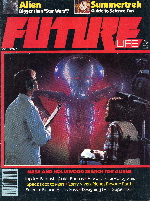
Future Life #11
72 pages (including covers)
Cover price: $2.25 |
Future
Life #11, July 1979
The cover shoot features an alien and two humans, whose identities would be revealed several years later when Starlog reprinted the photo in a special 3-D photo section. The scientist on the left is actually contributing editor David Hutchison, while the man seated on the right is editor Ed Naha. The photographer is Michael Sullivan, who would do many of the magazine's covers in its next three years. Sullivan is also, if my research is correct, from Cloud Studio, a New York-based art studio that included early National Lampoon, International Insanity, Cloud Comics, and other publications in its resume.
In
this issue: The contents page painting is by Chris Foss. Kerry O'Quinn pens a double-sized Output editorial on the Three Mile Island accident, warning against letting fear dictate nuclear policy; Input letters include a defense of Battlestar Galactica, praise for the magazine, feedback on planetariums, and more; short news in Databank includes Joseph Kay's report on Douglas Trumbull taking over the special effects for Star Trek – The Motion Picture, Barbara Krasnoff on a competition to design a future McDonald's, Leonard Davis on plans to use the space shuttle to take nuclear waste to space, Malcolm Brenner on a whale museum in Washington state, and more.
James C. Odell fills us in on advances in holography (with a short sidebar on "How to Make a Hologram");
John Billingham reports on NASA's search for extraterrestrial life; Ed Naha previews Alien; Bob MeCoy's In Print column reviews a bunch of books by Isaac Asimov (with a few other books, too); Scott Thom's art is featured in the centerfold; Philip Harrison interviews former astronaut Sen. Harrison Schmitt; an unbylined Video Images column showcases the designs for the odd TV show Supertrain; Barbara Krasnoff's "Summertrek" lists science-friendly places to visit; Ed Naha writes a humorous look at a post-nuclear future; James R. Stuart focuses on "Primitive Jupiter"; Michelle Green explains videodiscs; Robin Snelson profiles artist Chris Foss and features a portfolio of his paintings; Carolyn Henson's Alternate Space column looks at the role of third-world nations in the space race; and author Larry Niven pens the Tomorrow guest column, looking at wealth and space.
"A great deal can be learned from this accident – a great deal that will move us along the road toward the goal of absolute control and another triumph for the human race in our climb toward the future. But if we react with blind, emotional fear and abandon all the knowledge of atomic control that we have gained thus far, retreating toward the safety of candlelight and mule power, that indeed will turn Three Mile Island into a tragedy of incredible magnitude."
–Karry O'Quinn, publisher, Output
|
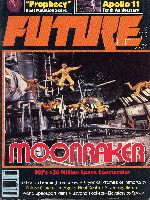
Future Life #12
72 pages (including covers)
Cover price: $2.25 |
Future
Life #12, August 1979
This is a very space-heavy issue. Unfortunately, it's also a Moonraker-heavy issue ...
In
this issue: The cover's featured photo is from the cheesy James Bond-in-space film Moonraker; the contents page starscape painting is by D. Owen Stevens. In his Output column, Kerry O'Quinn looks at "The Incredible
Shrinking Computer"; Input letters include thoughts on nuclear power post-Three Mile Island, more planetarium ideas, reactions to some recent SF movies and TV, and more; short news items in Databank include W.A. Thomasson on new color views of distant galaxies, Robin Snelson on Carl Sagan's upcoming Cosmos science series, Allan Maurer on a survey of engineers about robots, Barbara Krasnoff on Sony's PCM-1 digital audio processor, and more.
Within a year, Bob Woods will be the editor of Future Life, but for now, he's starting a new column called Earth Control, which he inaugurates with a look at Greenpeace; Walter Morton and Joseph Kay preview Moonraker; Jeffrey Elliot interviews Robert Silverberg about his return to SF writing; Jesco von Puttkamer recounts "The Last Day of the Old World" – when man stepped on another planet for the first time (planet, moon, what's the difference?); Bob MeCoy's In Print column reviews a lot of time-related books (and a sidebar announces the Nebula award winners); artist Geoffrey Chandler's work is featured in the centerfold gallery; Joseph Kay previews the horror film Prophecy; an unbylined article interviews musician Larry Fast about integrating computers with his work; the unbylined Video Images column updates the status of TV programs Beyond 1984, Brave New World, and Starstruck; Leonard David examines the promise of a space elevator; W.A. Thomasson reports on the possible climate futures for the planet -- fire or ice?; Carolyn Henson's Alternate Space column explores some ways to make money in space; Dr. Larry Smarr reports on Earthport – the plans for an international spaceport; Robert Anton Wilson and J.B. White look at "Cryonics and Future Perspectives," with a sidebar by Barbara Krasnoff on cryonics company Trans Time, Inc.; Carolyn Henson profiles artist Jack Olson; and Tomorrow guest columnist Alvin Toffler shares his thoughts on education in the future.
"Because change is so rapid, what we learn today may be totally passe tomorrow. Therefore, we also have to learn the skill of being tentative about what we know. We have to learn how to be uncertain rather than certain. We have to learn to be flexible, how to erase yesterday's tape and prepare a new one."
–Alvin Toffler, guest columnist, Tomorrow: "Learning for the Future"
|
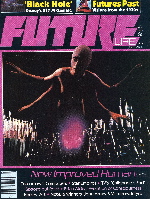
Future Life #13
72 pages (including covers)
Cover price: $2.25 |
Future
Life #13, September 1979
Science fiction, real-life space opera, computers, musicians, genetics – there was never a shortage of topics for Future Life to explore and use to fill up an issue.
In this issue: Photographer Michael Sullivan returns to photograph actress Paulette Sanders as a genetically enhanced human for the cover; a Jim Thompson painting is the contents page illustration. In his Input column, Kerry O'Quinn discusses biology and blasphemy; Input letters include criticism and praise for Carolyn Henson's new column, reactions to Alien, lots of comments on Three Mile Island, and more; short news items in Databank include Ed Naha on ABC's adaptaion of Childhood's End, Roger Guisinger on how space artists are correcting their extra-terrestrial images with the aid of actual images, Allan Maurer on the U.S. Department of Transportation's future scenarios, Robin Snelson on Pioneer's upcoming visit to Saturn, and more.
Philip L. Harrison tours Kitt Peak National Observatory; Richard Hutton reports on how how DNA research could change humankind; Ed Naha interviews Nebula Award winner Vonda McIntyre, while co-editor Robin Snelson interviews another Nebula winner, John Varley; David Houston previews Disney's The Black Hole; Charles Bogle then reports on another, cheaper Disney flick: Unidentified Flying Oddball; Bob MeCoy's In Print column reviews several Richard Matheson books, and others; artist Jim Thompson's work is featured in the centerfold gallery; Michael A.G. Michaud explores the SF-favorite concept of empires in space; Bob Woods' Earth Control column looks at endangered species; an unbylined Video Images column previews TV's The Martian Chronicles; Jon Pareles looks at the future of rock music (with a sidebar by Lou stathis on magazines covering electronic music); Carolyn Henson's Alternate Space column again looks at achieving financial success in the space field; Futures Past excerpts Tim Onosko's book, Wasn't the Future Wonderful, looking at earlier concepts for futuristic travel; Kerry O'Quinn continues his look (begun last issue in his editorial) at the way computers are dramatically changing; Robin Snelson profiles artist John Berkey in the magazine's Portfolio section; Brian W. Aldiss, writing the Tomorrow guest column, explores the evolution of consciousness.
"A great empire might be so far advanced technologically that we would not recognize its presence in what we see in the universe. Carl Sagan once observed that an ant walking beside a suburban swimming pool may be unaware of the evidence of a superior civilization all around him."
–Michael A.G. Michaud, writer, "Star Empires"
|
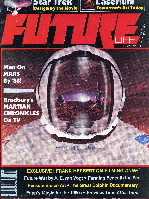
Future Life #14
72 pages (including covers)
Cover price: $2.25 |
Future
Life #14, November 1979
The cover boasts of a plan to put man on Mars by '88. Not to be a nay-sayer, but it's looking like 2088 might be a more reasonable target. In staffing news, Cheh Nam Low takes over for Robert P. Ericksen as the magazine's art director.
In
this issue: The cover painting is by David Egge; the contents page painting is by Andrei Sokolov. In his Output column, Kerry O'Quinn goes all Ayn Rand on us and takes on President Carter's call for sacrifice; Input letters include a Skylab lullaby, a call to action for NASA fans, a query about Stephen Hawking's ALS, and more; short news in Databank includes Michael A.G. Michaud on the search for extraterrestrial life, Charles Bogle (Ed Naha) on Saturn 3, Charles Bogle (again) on Atlas Shrugged's problems in coming to TV, and more.
Ed Naha previews The Martian Chronicles; Leonard Davis urges us to be on Mars by 1988; Malcolm Brenner looks at the documentary Dolphin; Barbara Lewis previews Time After Time; Bob Woods' Earth Control column promotes solar power; Bob MeCoy's In Print column reviews some end-of-the-world books; artist (and Future Life's space art advisor) Ron Miller's work is featured in the centerfold gallery; Nancy Naglin explores marine farming; Carolyn Henson's Alternate Space column predicts earthers-vs-spacers; an unbylined article offers an art preview of Star Trek – The Motion Picture; Malcolm Brenner interviews author Frank Herbert; the unbylined Video Images column previews Nova, Lathe of Heaven, and more; Michael Cassutt examines lasers used in entertainment; Brad Balfour profiles electronic musician Robert Fripp; F.C. Durant III profiles Russian space artist Andrei Sokolov; and A.E. van Vogt pens the Tomorrow guest column, looking at war in the future.
"Keeping the future war limited in scope will be, again, the hydrogen bomb. The former powers of the world, Britain, Germany, France, Italy, Spain and Japan will be forced into a position where they will maintain armies entirely for self defense. It would take only one or two hydrogen bombs to devastate any one of them and so they can never again engage in aggression."
–A.E. van Vogt, guest columnist, Tomorrow: "War = Peace"
|
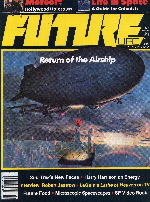
Future Life #15
72 pages (including covers)
Cover price: $2.25 |
Future
Life #15, December 1979
This is another of my favorite covers,
a neat mix of futuristic and classic. It could be a design
from a German 1920s magazine.
In
this issue: David Egge painted the cool cover painting (which is reprinted full-page on page 38); the contents page photo is by Duke Lee. In his Output column, publisher Kerry O'Quinn discusses manmade solutions to
nature's challenges; Input letters include a question about spaceports, criticism of O'Quinn's computer article, thoughts on DNA, and more; Databank short news items include Robein Snelson on Pioneer and Voyager visiting Saturn, Leonard Davis on the Soviets setting a new human spaceflight record; Ed Naha on a UFO guide, and more. A one-page survey asks for feedback on an upcoming careers in space article.
T.A. Heppenheimer writes "Lovers, Colonists, & Explorers: Scenarios for Space Settlers," about life in space; Carolyn Henson's Alternate Space column gives advice for finding the right space-friendly partner; Ed Naha examines SF rock video; Naha also previews Ursula K. Le Guin's The Lathe of Heaven, the public television adaptation; Bob McCoy's In Print reviews some best-of collections; Denise Watt-Geiger's work is featured in the centerfold gallery (and, not to sound like Joanna Russ here, but she is one of the few or even the only female space artist to be so featured); James Holahan and Adam Starchild (I assume that's his real name) contribute the cover story, "There's a Blimp in Your Future," about the revival in airships; Bob Woods' Earth Control column is incorrectly labeled "Alternate Space" (oops), but he nonetheless does his job and looks at the amazing properties of the Jojoba plant; an unbylined article previews the disaster movie Meteor; Pat Glossup interviews NASA's Robert Jastrow; Joseph Kay looks at the newcomers to the Star Trek universe in Star Trek – The Motion Picture; Nancy Naglin explores the food of tomorrow (which looks a bit like a Klingon banquet, according to the illustration by Jill Bauman); an unbylined portfolio features the photographic art of Dosuk Lee, who creates art out of microscopic scenery; and Harry Harrison writes the guest column Tomorrow, focusing on new sources of energy.
"Today's dirigibles are different in several respects from their earlier counterparts. As a rule, they are non-rigid, their shape sustained entirely by the pressure of the gas they contain. The gas now used is helium, which is less efficient than hygrogen but considerably safer. ... But the basic concept is unaltered: using a gas to freely suspend a heavy vehicle in the air."
–James Holohan and Adam Starchild, writers, "There's a Blimp in Your Future"
|
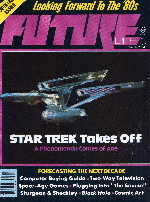
Future Life #16
72 pages (including covers)
Cover price: $2.25 |
Future
Life #16
This issue is focused on the new decade, one that would ultimately prove the prognosticators in this issue (including Herman Kahn, Edward Cornish, and others) rather wildly incorrect. It would also be the decade that would pretty clearly put an end to the magazine's expectations of a permanent manned presence in space any time soon.
In this
issue: The cover photo features the U.S.S Enterprise from the new Star Trek movie; the contents page painting is by artist Jon Lomberg. In his Output column, publisher Kerry O'Quinn considers hope for the new decade; Input letters include more responses to O'Quinn's computer articles, a call to go to Mars, a Christian Science Monitor staffer who wants a press pass on the shuttle, and more; short news items in Databank include Ed Naha on Carl Sagan's forthcoming Cosmos, Philip L. Harrison on "adventure capsules" for simulated travel at amusement parks, Jennifer L. Atkins on United Nations attempts to devise a treaty for dealing peacefully in outer space, and more.
Ed Naha previews Star Trek, "a phenomenon comes of age";
Carolyn Henson's Alternate Space column looks at homesteading in the solar system; Bjo Trimble interviews author Theodore Sturgeon (he of his own law); Stephen Sansweet highlights some "Space-Age Games" (a title which sister magazine Starlog would soon use for an ongoing video games column); three pages of predictions for the next decade's advances in various fields (aerospace, construction, medical, etc.) includes sidebar predictions from the Hudson Institute's Herman Kahn, The Futurist's Edward Cornish, futurist F.M. Esfandiary, and scientists Gerard K. O'Neill and Jesco von Puttkamer; Robert McCall's work is featured in the centerfold gallery; Barbara Krasnoff looks at Qube, a two-way television experiment; Chris Keller explores The Source online information system (it would be bought by Compuserve a decade later); Pat Glossop looks at three more computerized information systems -- Oracle, Ceefax, and Prestel; Philip L. Harrison and Margaret A. Taylor provide a buyers guide to home computers (such as an Apple II Plus for just $1,195); Bob Woods' Earth Control column reports on the Tellico Dam problems in Tennessee; the unbylined Video Images column previews some futuristic futurist television; David Houston and Ed Naha preview Disney's space opera The Black Hole; Bob McCoy's In Print column reviews The Right Stuff by Tom Wolfe, Disturbing the Universe by Freeman Dyson, and others; Robin Snelson profiles artist Jon Lomberg, with a portfolio of his work; and Robert Scheckley explores "The Future of Consciousness" in the Tomorrow guest column.
"The Source is the first nationwide information and service network to be offered to personal computer owners in the United States. By Tapping into The Source via telephone lines, home computer owners can receive instant national, international, loca, sports and financial news from united Press International, make airline reservations, buy or sell a home, find out what shows are playing in Los Angeles, learn a foreign language, or chat with others liked up to The Source. ... The Cost? Only $2.75 per hour during off hours and $15 between 7 a.m. and 6 p.m. weekdays."
–Chris Keller, writer, "Information for the '80s: The Source".
|
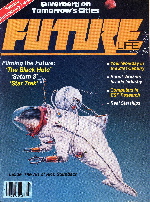
Future Life #17
84 pages (including covers)
Cover price: $2.50 |
Future
Life #17, March 1980
Future Life begins its third year of existence with its only extra-pages issue (made possible with a boost in cover price of 25 cents for this issue only). The magazine also sheds the iconic cover design of its first two years, freeing itself up to do more effective full-cover images, rather than being constrained by a central box. As much as I rather liked the branding effect of the earlier design, the dramatic covers we'll be seeing in a few issues demonstrate that they made the correct choice in doing away with the box. (Well, almost all of the box; this issue retains one leg of the box's border, directly underneath the logo. That line would also disappear with the next issue.)
In this issue: In this slightly oversized second-anniversary issue, the cover painting is by artist Rick Sternbach; the contents page image is a deep-space photo from the Black Hole movie. Publisher Kerry O'Quinn's Output column looks at advances in transportation; Input letters include arguing over space feminism (did I just coin a phrase?), gays in space, supporting the space program, responding to the anti-space Sen. William Proxmire, and more; Databank short news items include Barbara Krasnoff on plans for a "people mover" mass transit system for Los Angeles, Robin Snelson on private plans for space rocketry, Leonard David on France's space plans, and more.
Lucy Termerlin examines how advances in technology and lifestyle will affect the workplace; Barbara Krasnoff profiles science fan Cy Tymony and his plans for popularizing science; Pat Glossop chronicles Quatermass' return to television; Allan Maurer reports on efforts to find ESP; Sam Bisbee previews Saturn 3 (with an article titled "Lust in Space"); Barbara Krasnoff writes about robots as blue-collar workers; David Hutchison explores the computerized camera behind The Black Hole; artist Paul Lehr has the centerfold this issue; Ed Naha goes behind the scenes of the folks designing Star Trek's future; an unbylined photo feature article looks at fake spaceships across the country; Dr. Gregory Matloff reveals the truth about real starships (in an article illustrated with many beautiful spaceship paintings); Bob MeCoy's In Print reviews books by Phlilp K. Dick, Gordon Rattray Taylor, Norman Spinrad, Philip Jose Farmer, and others; The Future Forum queries Jack Williamson, John Varley, Octavia Butler, James P. Hogan, Poul Anderson, Richard Lupoff, Robert Anton Wilson, and Larry Niven on how science fiction can help prepare business for the future; Carolyn Henson's Alternate Space column investigates paper in orbit; Bob Woods' Earth Control column looks at hazardous wastes; Robin Snelson profiles artist Rick Sternbach in the portfolio section; and in the Tomorrow column, Robert Silverberg writes about urban living.
"The first starship of terran design that had any chance of working was a generation ship. Ironically, Project Orion, which could have propelled life into habitats where it could not have naturally evolved, was based upon the greatest weapons of mass destruction known to humanity."
–Dr. Gregory Matloff, writer, "Real Starships".
|
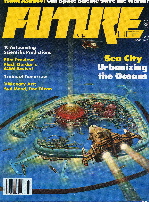
Future Life #18
76 pages (including covers)
Cover price: $2.25 |
Future
Life #18, May 1980
Following the anniversary issue, Future Life #18 takes on the format it would retain through the end of its life. Its page count goes up to 76 pages, but it trades a lot of the glossy pages for non-glossy, black-and-white uncoated pages.
In this
issue: The cover painting is by artist David Mattingly; the contents page painting is by Don Dixon. In his Output column, publisher Kerry O'Quinn defends abortion; Input letters include more controversy over the proposed U.N. moon treaty, a very anti-gay reader, questions about Carolyn Henson's family views, and more; short news in the Databank section includes Robin Snelson on a space colony film involving Gerard K. O'Neill and Robert McCall, Ed Naha on the Alan Arkin film Simon, W.A. Thomasson on genetic engineering, Bob Woods on talking magazines, and more.
Alan Brender explores what trains will look like in the future; Adam Starchild and James Holahan pen the cover story on sea cities; Bob Woods' Earth Control column looks at deforestation; Allan Maurer points out the derivative benefits to mankind of technology developed for the space program; Michael A.G. Michaud promotes the far side of the moon as a listening post; Joseph Kay previews the Dino DeLaurentiis Flash Gordon film; Pat Glossop provides an overview of the British science programs that appear on American television; artist Barclay Shaw's work is featured in the centerfold (and another of his full-page paintings illustrates Alan Brender's future trains article); Sam Bisbee reports on the costumes and fashions used in the Buck Rogers television program; Carolyn Henson's Alternate Space column looks at meat in space (saving us from a vegetarian future in orbit); Bob MeCoy's In Print column reviews books by Robert Anton Wilson, Nicolas Freeling, Stanislaw Lem, and others; Syd Mead's book Sentinel is excerpted in three pages of text and paintings; Ed Naha previews a humor book, The '80s: A Look Back at the Tumultuous Decade 1980-1989; Lou Stathis profiles musician Bernie Krause; Daniel E. Button interviews Future Life favorite Isaac Asimov; Barbara Krasnoff profiles artist Don Dixon, with a portfolio of his space art; and Charles Sheffield writes the Tomorrow guest column, "Ten Surprising Predictions for the Future."
"More and more of Earth's industry eventually will be lifted in space, where the problems of resource depletion – thanks to the Moon – and of pollution – thanks to the great volume of space – will be far less important. With industry on Earth's surface shrinking, that surface might return to a more desirable wilderness/park/farm condition. What's more, we would restore the beauty of the Earth without losing the material advantages of industry and high technology."
–Isaac Asimov, interviewed by Daniel E. Button: "Asimov at 60"
|
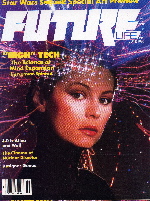
Future Life #19
76 pages (including covers)
Cover price: $2.25 |
Future
Life #19, June 1980
This issue features another of my favorite covers; it's bright, interesting, yet not too flashy. (I'm not nuts about cover story author Norman Spinrad's drugs-are-awesome views, but hey, it makes a nice cover.)
In this issue: The cool cover photo is by Michael Sullivan; the contents page photo is from a film called The Search for Solutions. In his Output column, Kerry O'Quinn argues for individual heroism; Input letters from readers include more talk about gays in space, someone who stopped reading the magazine when its cover price went from $1.95 to $2.25 but has now returned, watching Star Trek – The Motion Picture in Germany, and more; short items in Databank include Josephine Weiner on a flying saucer-themed restaurant, Joseph Kay on Mad Max, Franz Brinkerhoff on an upcoming remake of The Thing by John Carpenter, Barbara Krasnoff on a number of new tech gadgets, and more.
Barbara Krasnoff previews The Search for Solutions, a film that explores and explains science; artist Don Davis notes how space artists felt about seeing real Saturn images; Future Forum asks Roger Zelazny, Joan Vinge, Isodore Haiblum, Larry Niven, and others, "What explains the present lack of citizen interest in and support for the U.S. space program?"; Carolyn Henson's Alternate Space column looks at getting a job in orbit; Ed Naha talks with illustrator Ralph McQuarrie about his Empire Strikes Back paintings (many of which are shown in color); Naha also chronicles the use of nuclear disaster as a film subject; artist Edward Blair-Wilkins' work is featured in the centerfold gallery; W.A. Thomasson explains "The Gifts of Recombinant DNA"; Lou Stathis profiles the band The Residents; David Hutchison looks at the future of 3-D film technology; Michael Cassut writes a roundup of space activity by countries around the planet; Bob MeCoy's In Print column reviews books (fiction and nonfiction) having to do with black holes; Jeffrey Elliot profiles artist Morris Scott Dollens, along with a portfolio of his work; and Norman Spinrad's Tomorrow guest column says drugs in the future will be safer and more useful.
"Science fiction as a catalyst triggers the grandest sense of wonder, injecting mystery and curiosity into the usually static human mind – introducing original and lateral thought. ... SF is productive literature, provocative, ever-changing; it is fun and stimulating – like fresh air. ... My painting and drawing of this subject matter is my way of experiencing a hopeful future."
–Edward Blair-Wilkins, artist, quoted in introduction to his centerfold gallery
|
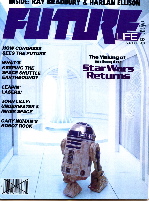
Future Life #20
76 pages (including covers)
Cover price: $2.25 |
Future
Life #20, August 1980
This is the last time Future Life would feature a film on its cover. The magazine would continue to cover science fiction films on a regular basis (from Flash Gordon to Altered States and beyond), but it's possible that with the move away from widespread newsstand distribution in a couple issues, the publishers felt they didn't need the eye candy on the cover to sell the magazine.
For what it's worth, this is also the first issue of Future Life that I ever purchased, after having paged through it numerous times at the bookstore where I went to pick up my copy of Starlog. I liked it, but I admit that I didn't quite get what it was; it covered science fiction like Starlog, but it also had all these articles on science and space and politics. I skipped the next issue, then bought the following one, deciding with issue #22 to become a regular reader. One issue later, the magazine reduced its circulation by stopping widespread newsstand distribution, and I wouldn't see another copy until five years later when I assembled an entire set through back issues.
In this
issue: The genius of the cover photo is that it looks like a calm, peaceful, even boring shot of a robot in a hallway. But, as everyone who has seen The Empire Strikes Back knows, this photo is actually from a rather suspenseful part of the movie that leads to the climactic lightsaber duel between Darth Vader and Luke Skywalker. This issue also sports a new contents page design that does away with the single image in favor of two or three smaller images. Meanwhile, in Output, Kerry O'Quinn introduces Harlan Ellison's new
column; Input letters include a movie producer defending himself against legal claims (you kind of have to read it to understand it fully), author G. Harry Stine gives an aw-shucks li'l ol' me response to being mentioned in an article, three readers give a thumbs-down on O'Quinn's pro-abortion editorial, and more; Databank's short news items include Barbara Krasnoff on a futurist conference in Toronto, W.A. Thomasson on the Einstein orbiting observatory, David hirsch on recent electronic toys, Allan Maurer on the true worth of the human body's components, and more.
Ed Naha goes behind the scenes of the eagerly awaited sequel The Empire Strikes Back;
dolphin expert Malcolm Brenner interviews dolphin magnet John Lilly ("Your God Isn't Big Enough"); James Oberg
delineates the problems with the space shuttle, while
Robin Snelson lays out the promises of the new space vehicle;Harlan Ellison's column,
"An Edge in My Voice," premieres, and he introduces himself and promises to be more raucous in future columns; Bob Woods' Earth Control column looks at the health of America's coastal areas; Bob MeCoy's In Print column reviews fiction and nonfiction books by Patricia Warrick, James P. Hogan, Joan Vinge, Larry Niven, Hilbert Schenck, and more; artist Raymond Crane's work is featured in the centerfold gallery; Ned Madden updates us on all of the cool things lasers are doing, such as entertaining us (with a sidebar on lasers in holography); the Video Images column finally has a byline, and this month Chris Keller describes plans for "SuperNews," which is ... CNN; Ray Bradbury contributes a poem, "We Are the Reliquaries of Lost Time"; Ed Naha goes behind the scenes of the Roger Corman SF flick Battle Beyond the Stars (and talks with James Cameron, who created spaceship models for the movie); Lou Stathis profiles musician Gary Numan; Allan Maurer looks at the "Congressional Clearinghouse of the Future," and while we're looking at Congress, Julian M. Weiss explains the legislative body's "Office of Technology Assessment"; Barbara Krasnoff profiles artist Karl Kofoed, with a portfolio of his paintings; and Carolyn Henson's Alternate Space column looks at politicking. No Tomorrow guest column this issue.
"The movie was a really tough assignment, ... What we had to do was capture the sense of each alien culture and represent it i the set. There are eight or so societies to cinsider. We tried to reflect each of the characters in their spaceships as well."
–James Cameron, art director for Battle Beyond the Stars, interviewed by Ed Naha: "Battling Time and Space"
|
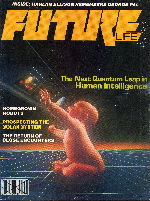
Future Life #21
76 pages (including covers)
Cover price: $2.25 |
Future
Life #21, September 1980
A sign of longevity, in print if not in human form: I recently heard from a reader of this online Future Life compendium who wanted a copy of the cover story in this issue, Robert Anton Wilson's six-pager on increasing human intelligence. That's nearly 30 years later. How many articles have that lifespan?
In this
issue: The cover photo (of baby Cory Cooper being educated to a high level) is by Michael Sullivan. In his Output column, publisher Kerry O'Quinn responds to (and disagrees with) guest columnist Gregory Benford on whether there are limits to
our knowledge; Input letters include James P. Hogan defending nuclear power, James Van Hise taking issue with Norman Spinrad's drug article, reader thoughts on space-based defense systems, and more; and Databank short items include Philip L. Harrison on a man who thinks we're using up all of our gravity, Raoul Tweel on a Cheech and Chong film, Pat Glossop on "The Jupiter Effect," Ed Naha on the No Nukes concert film, and more.
David Houston pens a Skylab obituary; Robert Anton Wilson writes
about increasing human intelligence ("The Last 4,000 Years and The Next 40 Years"); Barbara Krasnoff profiles some teenage inventors of robots; in his An Edge in My Voice column, Harlan Ellison remembers how the late George Pal was slighted by everyone in Hollywood, including Ellison; Ed Naha goes behind the scenes of the making of Roger Corman's Battle Beyond the Stars; Bob Woods' Earth Control column looks at the Japanese slaughter of dolphins; Ed Naha also reports on the re-release of Close Encounters of the Third Kind; artist Steve R. Dodd's work is featured in the centerfold; Stewart Nozette looks at the potential benefits of mining asteroids and other bodies in the solar system; Jeffrey Elliot interviews author Brian Aldiss; Ed Naha previews Galaxina; Michael Cassutt profiles "Captain Quantum," alter ego of physics professor Fred Alan Wolf; Carolyn Henson's Alternate Space column targets critics of solar power satellites; Chris Kuchler and Kenneth Walker examine the impact of digital technology on music, and Ed Naha provides a sidebar on Ry Crooder's Bop Till You Drop (a digitally mastered multi-track pop album); the magazine's space art advisor, Ron Miller, profiles artist Ludek Pesek and displays a portfolio of his atmospheric work; Bob MeCoy's In Print column reviews books by David J. Skal (Scavengers), Michael Berlyn (Crystal Phoenix), Gene Wolf (The Shadow of the Torturer), and more; and in the Tomorrow guest column, Gregory Benford writes
about "Aliens I Have Known."
"[B]efore I wrote for publication, intense reading of science fiction certainly shaped me. In particular the editorial work of John W. Campbell; I owe a lot to his preaching of independence of mind, and have cultivated that virtue – sometimes to the annoyance of the Campbell school!"
–Brian Aldiss, writer, interviewed by Jeffrey Elliot: "Brian Aldiss"
|
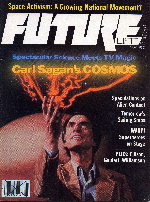
Future Life #22
76 pages (including covers)
Cover price: $2.25 |
Future
Life #22, November 1980
Carl Sagan, one of the great public scientists of modern times, is a big science hero – along with Gerard K. O'Neill – of the Future Life crowd. Long before he wrote Contact (later made into a film starring Jodie Foster), he created Cosmos, a public television series explaining the great mysteries and discoveries of physics for an educated but non-scientific audience. The series was also adapted into book form. Future Life features many of the space artists who worked on the series in its space art centerfold or in the portfolio section.
In this
issue: Edwardo Castaneda took the photo of Carl Sagan for the cover, and Michael Sullivan did the composite artistry to create the image. In his Output column, Kerry O'Quinn criticizes the military draft – recently reintroduced by then-President Jimmy Carter – as being an afront to personal
freedom; Input letters include more complaints about the Moon Treaty, an attempt to get Future Life to organize pro-space voters, a defense of vegetarians in space, and more; and in Databank, short news items include Barbara Krasnoff on the Museum of Holography, Susan Adamo on costume designer Durinda Rice Wood (who did costumes for Battle Beyond the Stars as well as the band Devo), an unbylined note that Ed Naha is no longer a co-editor of Future Life, Lou Statis on the band Los Microwaves, and more.
In her Alternate Space column, Carolyn Henson examines "The Vice Potential of Zero-G"; Robin Snelson and Ed Naha go behind the scenes of Carl Sagan's groundbreaking Cosmos public television series; Trudy E. Bell compiles a compendium of pro-space activist groups; departing co-editor Ed Naha's new book Wanted! is excerpted; Jack Imes, Jr., looks at how people are reinventing the wind-powered ship in "Supersail: The Wind Solution"; Jeffrey Elliot interviews author Jack Williamson; Bob MeCoy's In Print reviews books, including Gregory Benford's Timescape, Robert L. Forward's Dragon's Egg, Bruce Sterling's The Artificial Kid, and more; artist James L. Cunningham's work is featured in the centerfold; Barbara Krasnoff explores Stuart Gordon's stage play Warp!; Barbara Wechsler looks at psychegenics,
Win Wenger's mind game; Harlan Ellison's An Edge in My Voice column takes aim at directors; Lou Stathis profiles synth musician Patrick Gleeson and his electronic music;
Barbara Krasnoff looks at James Pelletier, an artist who choreographs light waves; Ed Naha previews The Final Countdown; Jeffrey Elliot conducts the future forum, asking Ted White, Mack Reynolds, Octavia E. Butler, George Zebrowski, and others, "How do you envisage first contact with an alien race?"; Robin Snelson profiles Adolf Schaller in the portfolio section; Bob Woods' Earth Control column reports on the dangers of acid rain; and in the Tomorrow guest column, Ron Goulart explores futurist fantasies and follies.
"After two and a half years of blood, sweat and yogurt, Naha has left the Future Life offices pursuing a career in freelance writing. ... Well-known for his red bozo nose and threatening remarks to the publishers, Mr. Naha will be missed by several readers in the Ontario area ... who have never met him."
–unsigned Databank item: "Onward and Upward"
|
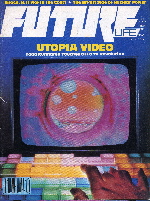
Future Life #23
76 pages (including covers)
Cover price: $2.25 |
Future
Life #23, December 1980
All of the article fonts in the magazine have been increased slightly, probably by one point size. Why? One can only guess, but bigger text means fewer words, and a small magazine that's not very profitable might have been looking to save some money in the fees per word its writers receive. Articles that take up more pages also mean fewer articles overall. Either way, money saved.
In this
issue: The cool cover involves a video image by Todd Rundgren, photographed by Elliot Landy, and cover photography by Michael Sullivan. Kerry O'Quinn often uses his editorials in his magazines to sell things, and this issue he announces that Future Life will
no longer be sold on newsstands and will become a subscription-only
magazine; Communications letters include readers correcting the pro-nuclear math in James P. Hogan's recent letter (and a letter from Mr. Hogan himself apologizing for the error), Ron Miller on the recent article about mining asteroids, pro and con letters about columnists Harlan Ellison and Carolyn Henson, and more; short news items in Databank include Susan Adamo on the feminist fantasy play Starstruck, Barbara Krasnoff on the Hugo awards at the 38th World Science Fiction Convention in Boston, Lou Stathis on the band Our Daughters Wedding, Richard B. Cathcart on ideas for improving Antarctic travel, and Barbara Krasnoff on the space policies – or lack thereof – of presidential candidates John Anderson, Jimmy Carter, and Ronald Reagan.
Ed Naha uncovers rock musician Todd Rundgren's video revolution; Carolyn Henson's Alternate Space column promotes the benefits of runnning on the moon; M. Berkenwald and Christopher John interview writer Norman Spinrad about the media, religion, and more; Lou Stathis explains Devo's new-wave music; Bob Woods reports on bigger and
better aircraft (I don't think any of them ever got built, though); in his An Edge in My Voice column, Harlan Ellison has some tough love for the sometimes somewhat odd SF fans; Ed Naha previews the never-made David Gerrold film adaptation Starhunt (also see this article and interview with David Gerrold I wrote
nearly two decades later); artist Robert J. Rich's work is featured in the centerfold; Trudy E. Bell examines the financial costs and payoffs
of the U.S. space program in "Space: Is It Worth It?"; Ed Naha highlights the costumes of Flash Gordon; in his In Print column, Bob MeCoy reviews some best-of short story collections, David Macaulay's Unbuilding, and more;
Bob Woods' Earth Control looks at the plight of the Whooping Crane; Ed Naha profiles the career and art of Ron Cobb in the portfolio section; and author James P. Hogan makes the case for nuclear power in the Tomorrow guest column.
"In short, cold hard money facts demonstrate that although five billion dollars is a lot on an individual scale, in the whole Federal picture it represents less than one percent of the whole. ... Ironically, late in 1978, HEW revealed that it had lost $7 billion – one and a half times NASA's budget – due to welfare fraud and inefficiency. Please do not take my word for it alone: Examine the Federal budget yourself. Bandying about money figures can easily deceive."
–Trudy E. Bell, writer, "Space: Is It Worth It?"
|
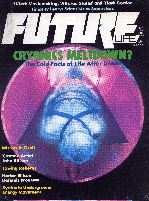
Future Life #24
76 pages (including covers)
Cover price: $2.25 |
Future Life #24, February 1981
This issue has a great cover; good composition and execution. Eye-catching. Alas, this issue is also noteworthy for a cover typo that labels it as "Feb. 1980" though it's really the February 1981 issue.
The topic of the cover story is, as they say, oh-so-1981. Perhaps only in the time of coke-and-Reaganomics could many people be tempted to have their cadaver's heads chopped off, frozen, and tended by grad students or temps for, what? Tens of years? Hundreds? Thousands? Really? In earthquake country, they thought there'd never be a disruption in the power supply? Ah, well. Still, it's a cool cover.
Every year, magazines publish a Post Office form publicizing their ownership and circulation. (It's a necessary part of delivering subscriber copies via the mail at reduced periodicals rates.) This is the one and only time Future Life ever published one; whether that was because it never before had subscription numbers high enough to require it, or it just slipped the publishers' minds, who knows? Anyway, its average paid circulation for the previous 12 months is listed as 106,554, but that drops to 38,250 for the issue most recently published before the form's filing. That was before the magazine stopped distribution through newsstands and most retail outlets and went to an almost all-subscription model. That might even help explain why it took that drastic step. Those numbers include an average of 5,300 mail subscriptions (6,000 for the single issue cited above).
In this issue: The cover photo is by ace photographer Michael Sullivan. In his output column, publisher Kerry O'Quinn cites guest columnist Timothy Leary to illustrate the importance of scientists as inspiration and leaders; the letters in the Input pages include a rather ill-temered Adolf Schaller (who seems to take great exception to a rather minor point in his recent portfolio profile in the magazine), feedback on O'Quinn's anti-draft editorial, praise for Trudy Bell's space activism article, a pro-pot activist chiming in on Norman Spinrad's recent column, and more; Databank short items include Bob Woods on new-fangled windmills, Charles Bogle (and we know who that is by now, don't we?) on upcoming SF films (including a John Sayles-scripted Spielberg flying saucer flick), Randolph J. Steer on the U.S. Air Force's plans for space, an unbylined item on the application of science to solving problems with rice-destroying fungus, Philip L. Harrison on "magnetic smog," and more.
Ed Naha reports on the special effects technology behind Dino De Laurentiis' Flash Gordon; Carolyn Henson's Alternate Space covers the political slugfest over solar-powered satellites; Barbara Krasnoff investigates the cryonics industry ("Cryonics Meltdown"); Lou Stathis profiles avant-garde musician Jon Hassell; Ed Naha previews Ken Russell's film Altered States; in An Edge in My Voice, Harlan Ellison defends the concept of scientific progress; artist Kevin Ward's colorful work is featured in the centerfold; Michael Cassutt interviews scientist/writer Gregory Benford; Bob MeCoy's In Print column reviews some alien-related books, and more (including a review of John Varley's The Barbie Murders, which I can only hope is about what it seems to be about); in a special Energy Alternatives section, Bob Woods updates us on the progress of synthetic fuels development, and Stan Kent explains the potential of Solares (orbiting mirrors to reflect sunlight to ground stations on the earth); Bob Woods also pens his regular Earth Control column, this time looking at the controversial ides of towing icebergs from the poles to water-deficient areas; Robin Snelson profiles artist John Allison (one of the folks working on Carl Sagan's Cosmos TV series) and his work in the portfolio section; and Tomorrow guest columnist Timothy Leary writes about scientists as superstars.
"Succinctly, what I like least about SF is that all too often it's tennis with the net down. It either completely finesses the scientific constraints on a story, or fails to treat the characters or scene realistically. Instead – to pick an author who has great virtues and great faults – it's like the background in a Philip K. Dick novel: it's just pasted on. Now, I know that often Dick is not trying to write a 'realistic' novel, but sometimes he is. Nonetheless, his backgrounds are still the same papier-mache with paint on them. That happens a lot in SF."
–Gregory Benford, scientist and writer, interviewed by Michael Cassutt: "Gregory Benford"
|
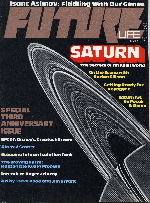
Future Life #25
76 pages (including covers)
Cover price: $2.25 |
Future
Life #25, March 1981
Future Life celebrates the completion of its third year of publication. Unlike the second anniversary issue (#17, see above), there are no extra pages and the only special item in the issue is the publisher's special editorial, which at least does a good job of being an unabashed pro-science, pro-rationality statement. The real treat of the issue is the cover story, in particular, Harlan Ellison's reporting from the Jet Propulsion Laboratory as the Saturn data comes in.
In this
issue: The cover features a Voyager 1 photo of Saturn's rings. Kerry O'Quinn writes a special anniversary Output
editorial about discarding ancient superstitions (it's O'Quinn in top form, and it's a great tone-setter for the magazine itself; it is also illustrated with the Boris Vallejo painting that was used on the cover of Future Life #3 and which caused some consternation due to the lack of modesty on the part of the man and woman depicted); Input letters include critical thoughts on Harlan Ellison, a call for the magazine's readers to contact Washington and support the program of planetary exploration, feedback from space activists, and more; short news items in the Databank section include Malcolm Brenner on Euro-Asian Laughing Warthog Productions, Barbara Krasnoff on Israeli solar power projects, Bob Woods on the development of "supertrees," David Hutchison on 3-D television, Barbara Krasnoff on the imprisonment of Ukrainian science-fiction writer Oles Berknyk, and more.
Harlan
Ellison is on the scene at the Jet Propulsion Laboratory
during Voyager 1's Saturn flyby, and a sidebar by Richard C. Hoadland and the photographer Ctein (more from him in a few issues) discusses taking your own Saturn photos; Ned Madden examines the aging population of earth; David Hutchison goes behind the scenes at Disney's Epcot Center at Disneyworld;
Carolyn Henson's Alternate Space column looks at lawyers and the law in space; Lou Stathis profiles musician Captain Beefheart; artist James A. Bryant's work is featured in the centerfold; W.B. Thompson interviews writer Roger Zelazny; Ed Naha visits the set of Altered States; editor Bob Woods reports on his experience in an isolation tank (a la Altered States), and he pens a sidebar looking at Dr. John Lilly's pioneering work with the tanks; Woods also writes his regular Earth Control column, and this month he discusses extinction triage; Bob MeCoy's In Print column reviews The Hitchhiker's Guide to the Galaxy, Galaxies, Dream Makers, and more; Barbara Krasnoff profiles artist Steve R. Dodd and his work in the portfolio section; Ed Naha talks with director David Cronenberg about his new film, Scanners; and in the Tomorrow guest column, Isaac Asimov returns to write about changing
genes.
"But most remarkable of all is the revelation that three components of the F ring seem to defy the laws of pure orbital mechanics: they are braided. Such a thing cannot be, yet we look at the photographs and we see that indeed, the rings to twine. Brad Smith of the University of Arizona is totally at a loss to explain it. He cannot even make a joke. This is the big time, something never encountered before. He looks like a man stunned by the hammer. He says that of all the improbables he might have postulated, even to the inclusion of eccentric rings, which have now been verified, the braiding is so far off the wall he could not even have conceived of it. We stare at the pictures."
–Harlan Ellison, writer: "Saturn"
|

Future Life #26
76 pages (including covers)
Cover price: $2.25 |
Future
Life #26, May 1981
A cover note: This is a great cover. It's a simple photo of a model of a futuristic house, but the composition of the cover, placement of text, and choice of colors are outstanding.
In this
issue: The cover photo (and the architecture exhibit photos inside the magazine) is from the Leo Castelli Gallery. Kerry O'Quinn's Output column explains "The Future Life Philosophy,
Part I: The Overall Theme"; Input letters include more on the politics of the space program (there was continuing discussion in the magazine at this time over whether the new Republican administration of Ronald Reagan would prove to be a boon or a bust for NASA), a Motorola employee takes the magazine to task over its attribution of certain technologies to the space program, a Welsh reader chimes in with thoughts on nuclear weapons, and more; in the Databank section, brief items include Barbara Krasnoff on cloned mice, Lou Stathis on musician Francois Breant, Bob Woods on the Hong Kong Space Museum, Barbara Krasnoff on SF radio, and more.
Bob Woods looks at the houses of tomorrow, displaying architects' visions of residential futures; Carolyn Henson's Alternate Space column examines the concept of lasers in space; Ed Naha profiles B-movie legend Roger Corman (the subject of a book by Naha); Malcolm Brenner interviews author Poul Anderson; David L. Nicol examines the interstellar promise of ion propulsion; Harlan Ellison's An Edge in My Voice column shares his responses to reader mail (one of my all-time favorite Ellison columns, just for
its sheer Ellisonness); artist Thomas Boud's work is featured in the centerfold; Bob MeCoy's In Print colum reviews a number of tech books, and a special one-page review by Robert Anton Wilson looks at R. Buckminster Fuller's book Critical Path; Ed Naha previews the Peter Hyams-directed SF film Outland; Barbara Krasnoff looks at the roles of women in science fiction films; Lou Stathis, who has been writing for Future Life about electronic musicians for a while now, debuts a proper column called Soundscapes, and in this first installment, he lays the groundwork for an exploration of modern electronic music; Barbara Krasnoff profiles artist Dale M. Figley and his paintings in the portfolio section; Abby Gelles reports on Carnegie-Mellon's Robotics Institute in Pittsburgh; Bob Woods' Earth Control column looks at ecology politics, and Tomorrow guest columnist G. Harry Stine considers scientists vs. engineers.
"Princess Leia Organa from Star Wars and The Empire Strikes Back is the epitome of spunk. Placed in the rather traditional role of damsel in distress, she immediately disconcerts her erstwhile heroes by taking charge of her own rescue. She stands up to the evil Darth Vader with considerable aplomb, wields a mean laser pistol, and even, in Empire, gets to pilot a starship after its owner is hijacked. All in all, a pretty neat lady."
–Barbara Krasnoff, writer: "From Housewife to Heroine: Women in SF Media"
|

Future Life #27
76 pages (including covers)
Cover price: $2.50 |
Future
Life #27, June 1981
A bit of a double-whammy this issue. The cover price goes up 25 cents, and the magazine changes all of its color pages to uncoated (non-glossy) pages. They still print nice full color on them, and the magazine has the same number of color pages, but they are no longer glossy. No doubt the early 1980s' recession is taking its toll on the small publishing house, but this magazine's fortunes were also not promising at this time.
Meanwhile, Survivalists – the same sort of people we'd later call militias and all sorts of other unfriendly terms – were just starting to get mainstream attention back in 1981, so their central role in this issue is timely. They do represent a future. Just not a good one. Future Life is a relentlessly positive, optimistic magazine, unlike rival magazine The Futurist (which has always seemed to be a depressingly doomsaying magazine). But the survivalists are opposed to the core of the Future Life philosophy; they expect the worst, they expect (even welcome?) the decline of civilization, they expect the failure of society and technology, and they actively plan for the day they can take their guns and canned spam and become the new rulers of their neighborhoods. They're not exactly planning how they'll arrange the furniture on their space station apartment.
In this issue: The cover photo is by longtime photographer Michael Sullivan, who also provides the lead picture for the cover story. In his output column, Kerry O'Quinn explains "The Future Life Philosophy, Part II: Free Enterprise" (a pretty self-explanatory title); in the Input section, there's lots of reaction (pro and con) to publisher O'Quinn's anniversary editorial (including a few people who take exception to his criticism of their religious beliefs), a Canadian corrects the national chauvinism of American science-fiction, a reader praises Harlan Ellison's reporting on the Saturn explorer, and more; brief items in the databank section include Bob Woods on microphages, Barbara Krasnoff on the Audium theater, Philip L. Harrison on the latest thinking about Pluto, Richard Brook Cathcart on extra-terrestrial mining, Godfrey Andolphi on an energy machine out of Iowa, and more.
Suzanne Weyn reports on the phenomenon of survivalists; Larry Gartel takes a look at video art – "electronic sculpture"; Carolyn Henson, in her Alternate Space column, boosts the boosting of science; Ed Naha takes another look at the Sean Connery film Outland; Karl T. Pflock interviews pro-nuclear scientist Petr Beckmann; artist Kent Bash (who would contribute illustrations to Future Life in a few issues) is featured in the centerfold; in a special section on "Living in Space" (kicked off with a painting by Russian space artist Andrei Sokolov), James E. Oberg reports on medical barriers in space (an article reprinted from Star & Sky magazine), Barbara Krasnoff explores the latest space suits, Robert Strahan looks at NASA's plans for a permanent manned space station, and Krasnoff (again) on designing for human habitation in space; Lou Stathis' Soundscapes column looks at the success of technorock; in his An Edge in My Voice column, Harlan Ellison takes on the Moral Majority and creationists; in the portfolio section, Bob Woods explores the solar system via a colorful travelogue by artist (and Future Life's space art advisor) Ron Miller; Bob Mecoy, in his In Print column, reviews new books by Frederik Pohl (Frederik Pohl's Favorite Stories), Damon Knight (Orbit 21), Nicholas Yermakov (Journey from Flesh), and more; Bob Woods' Earth Control column takes a look at plans to clone a woolly mammoth; and F.M Esfandiary, this month's Tomorrow guest columnist, explains "Up-Wing priorities for 2010 A.D."
"There is no best form of energy for all applications. For some, the direct burning of fuel has the most advantages. For others, converting it to electricity first is best. The best mix is found automatically by the free market, Adam Smith's invisible hand. For the generation of electricity, the answer is quite clearly nuclear, on all counts. If there were no political roadblocks, it would be the certain choice of the utilities. In fact, before it was politically priced out of the market, nuclear was always their first choice. But now they are coerced into using other less safe and environmentally benign methods."
–Petr Beckmann, electrical engineer and author, interviewed by Karl T. Pflock: "Petr Beckmann"
|
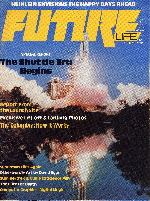
Future Life #28
76 pages (including covers)
Cover price: $2.50 |
Future
Life #28, August 1981
The magazine celebrates in grand style as one of its dreams comes true: A reusable spaceship, the U.S. space shuttle, has its inaugural flight. For the first and only time, the centerfold is changed from a painting to a photograph (by photographer Ctein) of the shuttle launch.
In this
issue: There's not a credit for the cover photo, but the shuttle photos inside the issue are by Ctein, NASA, and Terry A. Garey, so the cover photo is likely from one of those sources. In his editorial column, Kerry O'Quinn continues with "The Future Life Philosophy,
Part III: Individual Liberty"; letters in the Input section include
reader thoughts about evolution, survivalists, Harlan Ellison, Carolyn Henson, and more (including a letter from Henson following up on The Great Jogging on the Moon Controversy); Databank short items include Bob Woods on The Halley Fund (organized to promote a rendezvous with Halley's Comet in the mid-1980s), Cathy Stone on mass-produced wind farms, Christina Westcott on how climate change could flood one-quarter of Florida, Bob Woods on the Purpose I psychotherapeutic chair (think of the egg chair in the TV interview scene from the Tim Burton Mars Attacks movie), and more.
Bob Woods reports from Kennedy Space Center on the first launch of the space shuttle Columbia
(with photos by Ctein and others); Jesco von Puttkamer explains how the shuttle works; Alan Brender describes the special effects used to create films promoting the
shuttle; Peter H. Christiansen explores "emortalism" and the attempts to live
forever (with a painting by artist Walter Velez); Ed Naha previews Superman II; Barbara Krasnoff interviews scientist and author Robert L. Forward; Carolyn Henson's Alternate Space column discusses fire in space (good and bad); Ctein's space shuttle photos are highlighted in the centerfold; in his Edge column, Harlan Ellison continues his engagement with the Moral Majority (he still doesn't like it); appropriately for an issue featuring the new space shuttle, Bob MeCoy's In Print column reviews some real-space books, such as Richard Hutton's The Cosmic Chase and James Oberg's Red Star in Orbit (soon to be excerpted in Future Life), among other books; Barbara Krasnoff offers up "Summertrek II," a list of science-friendly
things to do; Lou Stathis' Soundscapes profiles Otto Luening; the Tomorrow guest columnist is a special, extra-long column by Robert A. Heinlein, "Over the Rainbow–," about solving the world's problems (reprinted from Expanded Universe); Ron Miller profiles young artist David Egge and his paintings in the portfolio section; Robert Greenberger looks at how the future is being taught in classrooms, including a three-page list of such classes; and David Beauvais explores computer graphics being used to creat art by Jim Hoffman, who also pens a sidebar explaining his interest in the budding art form.
"If I had been born 50 years ago, I would have been another Edison or something like that. The trouble is, nobody can be an inventor anymore, because things are too difficult. You can't invent microcircuits; you have to have the science to do that. I've done a little bit of that kind of intuitive inventing, but because I'm a scientist and know the technology, I can do it at a higher level."
–Robert L. Forward, scientist and author, interviewed by Barbara Krasnoff: "Dr. Robert L. Forward"
|
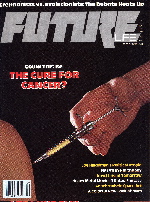
Future Life #29
76 pages (including covers)
Cover price: $2.50 |
Future
Life #29, September 1981
Progress has definitely been made since 1981 on the search for effective treatments for cancer, but we could just as likely see a cover story in a magazine today, in 2010, as we see back in September 1981, called "Could This Be the Cure for Cancer?" Timely then, timely now. Probably different potential cures, though.
Watchers of details might note that this issue the UPC bar code box returns to the cover of the magazine, just a half-dozen issues after it was removed. I don't know if that means the publishers made a last-ditch effort to expand distribution again or if their limited distribution at Waldenbooks and specialty stores (comics and science-fiction shops, for example), required that they put the UPC box back. But it's there. For all three final issues.
In this
issue: The cover photo, not one for needle-phobes, is by Michael Sullivan. In his Output column, publisher Kerry O'Quinn continues explicating "The Future Life Philosophy,
Part IV: Scientific Progress"; in the Output letters pages, Kerry O'Quinn's anniversary editorial is still stirring up thoughts, the creationist debate flares up, a reader chastises the magazine for giving room to cranks, and more; in the Databank section, short items include Sue Adamo on the victory tour by the shuttle Columbia's astronauts, Dean Gengle on efforts to create an electronic bill of rights for computer users, Bob Woods on the Solar Sail Project, David Hutchison on a video music production, and more.
Harvey J. Berman explains plans for the Space Telescope; Richard Levine reports on some students with telescope plans of their own; Dean Gengle interviews author (and Future Life contributor) Robert Anton Wilson; Barbara Krasnoff delves into the standoff between scientific evolution and religious creationism; Ed Naha previews the Heavy Metal movie (the only article in Future Life ever to feature a photo caption like this: "Den coddles his large-breasted lover in the woods"); in her Alternate Space column, Carolyn Henson looks at space efforts from the Third World; Lou Stathis' Soundscapes column looks at The Stranglers; artist Kikuo Hayashi's work is featured in the centerfold gallery; Harlan Ellision's An Edge in My Voice column continues his broadside against the Moral Majority, and it also includes a surgical attack on the movie Outland; Bob Woods' Earth Control column profiles the Nature Conservancy; Barbara Krasnoff shows off some colored photos of Mars; Bob Woods looks at "Investing in the Future"; Barbara Krasnoff profiles artist Keith Page and his colorful paintings in the portfolio section; Cathy Stone examines interferon and the promise of recombinant DNA in the fight against cancer; books reviewed in Bob MeCoy's In Print column include two by Robert Anton Wilson, Gregory Benford's Timescape, two by Gene Wolfe, Gerard K. O'Neill's 2081 – A Hopeful View of the Human Future, and more; and Joe W. Haldeman's Tomorrow guest column looks at the future of democracy.
"There are groups who feel that this is the right time, because of the mood of the country, to return God to the classroom. They couch it in these words – that evolution is an example of secular humanism, which basically is an atheistic approach. And so what they're really saying is that, if you teach evolution, you deny the existence of God. I never denied the existence of God. Those of us who teach evolution never deny the existence of God. We never mention it, we never teach about God, we don't talk about God in the science classroom."
–Jerry Resnick, biology teacher, quoted in "From Whence We Came: Creationists vs. Evolutionists," by Barbara Krasnoff
|
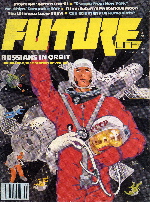
Future Life #30
76 pages (including covers)
Cover price: $2.50 |
Future
Life #30, November 1981
The cover story of this issue is an excerpt of a book by noted science writer James Oberg on the Soviet space program. I think it's a great cover; well designed and executed. But it's also worth noting that competitor Omni magazine also excerpted (or previewed?) this book – two and a half years earlier (see Omni, May 1979, "Red Star in Orbit," by James Oberg).
In this
issue: The cool cover painting is by artist Walter Velez. In his Output column, Kerry O'Quinn uses Escape from New York as an excuse to complain about the lack of positive
inspiration in popular culture; letters to the editor in the Input section include pro and con on Robert Heinlein's recent article about solving all of the world's problems, more on the first shuttle launch, a fan of the band Rush, and more; and short news items in Databank include Bob Woods on the relationship between lighting and people's emotional health, Barbara Krasnoff on Harrison Ford's next movie (Blade Runner), Becky Sharp on the new TV special Walter Cronkite's Universe, Bob Nichols on plans for the second launch of the space shuttle, and more.
In an excerpt from his book Red Star in Orbit, James Oberg reveals the Soviet
Union's plans for a permanent space station; Bob MeCoy's In Print column reviews novels whose covers almost all look like romance novels (my description, not his); Carolyn Meinel Henson (now adding what I assume is her maiden name) uses her Alternate Space column to look at laser-powered spacecraft; John C. Lautsch predicts big changes to education caused by the computer revolution (with an illustration by Howard Cruse); Tobias Owen shares the latest thinking on Saturn's moon Titan; editor Bob Woods interviews one of the magazine's heroes, Gerard K. O'Neill; artist Janny Wurts' workis featured in the centerfold gallery; in An Edge in My Voice, Harlan Ellison eviscerates Outland; Ed Naha previews John Carpenter's dystopic film Escape from New York; Barbara Krasnoff looks at the laser light show Crystal Odyssey – A Classical Fantasy; Bob Woods' Earth Control column updates us on happenings in the world of botany; Barbara Krasnoff profiles artist Ronald F. Hall and his paintings in the portfolio section; Lou Stathis' Soundscapes column profiles Frank Tovey (aka "Fad Gadget"); in the first of what looks like a continuing effort to highlight historical Big Men of science, Malcolm Brenner profiles Nikola Tesla; and author Jack Williamson pens this month's Tomorrow guest column, comparing scientists and humanists, and noting the connections between the two.
"Appalled by Hiroshima and Nagasaki, [Robert Oppenheimer] spend the rest of his life as the humanist, trying to undo or atone for what the scientist had done. He tried to stop the effort led by Edward Teller to develop the hydrogen bomb – which is a thousand times more powerful. He worked for international control of atomic knowhow under the United Nations. He shocked many of his fellow scientists by announcing that the physicist had known sin. It's ironic, I think that his science was such a blinding success, his humanism such a tragic failure."
–Jack Williamson, writer, Tomorrow column, "The Scientist, The Humanist, and Us"
|
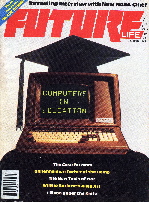
Future Life #31
76 pages (including covers)
Cover price: $2.50 |
Future
Life #31, December 1981 (final issue)
In its short four years of existence, Future/Future Life had the somewhat unique experience of getting better each year, even though almost every year saw a pretty dramatic shift in design and sometimes content. Some magazines kind of flail about as they approach their end, as they desperately seek to attract readers at any cost, and they usually debase themselves somewhat. But Future Life got better, adding interesting profiles of famous scientists, perceptive articles on hot topics such as the creationist threat, and getting, if anything, more serious than it had been. That's a credit to the magazine's editors and publishers (and writers and artists), and it also is just one more reason to mourn the loss of this magazine.
Sharp-eyed readers will
note that the magazine made a minor change to its logo
with this issue, separating the "U" and "R"
and dividing the "T" from the "U."
Welcome changes, but, alas, too late.
In this
issue: The cover photo is by Michael Sullivan. In his final Output column, Kerry O'Quinn's editorial focuses on one of his favorite topics: space artists; Output letters to the editor include feedback on recent articles about creationism and the Moral Majority, a response by artist Ron Miller about scientific accuracy in one of his paintings, pro-space fans, and more; and short news items in the Databank department include Christina Westcott on automobile design, Barbara Krasnoff on a new space-themed attraction from Trans-Lux Corporation, Lila Finck on space-based answers to questions about plants, Bob Greenberger on the creation of Carl Sagan's Planetary Society, and more.
Bob Woods
looks at the growing role of computers in education; in his Soundscapes column, Lou Stathis profiles German synthband Kraftwerk; Willard van de Bogart examines the implications of information networking; Stan Kent makes "The Case for Mars" (with help from a painting by Paul Hudson); Bob MeCoy's In Print column is on a theme: first-time publishing efforts; artist Frank Thomas (no, not the White Sox slugger) is featured in the centerfold gallery; Trudy E. Bell interviews Reagan administration NASA administrator James Beggs; Barbara Krasnoff looks at some of Syd Mead's production illustrations for the film Blade Runner; in his An Edge in My Voice column, Harlan Ellison attacks slasher flicks; Bob Woods' Earth Control column looks at an environmental boondoggle; Bob Woods also profiles Wayne Barlowe and his fantasy paintings in the portfolio section; Barbara Krasnoff profiles atomic bomb "father" J. Robert Oppenheimer; and in the final Tomorrow guest column, Roland J. Green and Clyde R. Jones explore the means of future war. Hey, it was the Reagan years.
"[T]he question for this agency has always been whether that popular appeal translates itself into votes in any significant way. And in the past, I think the general perception of political powers-that-be in this country is that it did not – that it's not something that people vote for. They don't vote their desires for greater participation in space activities. But I think that it is part of a general feeling or a general perception in the public that an Administration is either doing well or poorly, depending on whether they are pusruing the kinds of advanced technology that they perceive to be desirable, important and so forth.... I think if the Administration has the aura of exploring the unknown in an active, aggressive way, that it will have a political effect."
–James Beggs, NASA administrator, interviewed by Trudy E. Bell: "James Beggs"
|
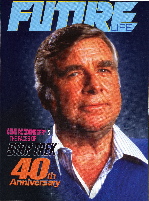 |
Post-Mortem
Future
Life made a return – sort of – as a one-time
special section on Star Trek's 40th anniversary in
the October 2006 issue of Starlog (which occasionally
used logos of defunct Starlog Group magazines to head up
special feature sections; it's a cute practice, but it begs
the question: Are they doing it to keep some sort of copyright
control over the names and logos?). Neat idea. But mainly
mentioned here for the fact that they once again slightly
altered the logo -- overlapping the "U" and "R"
once again and fully reconnecting the "T" and
"U" – both bad moves, in my humble opinion.
But they also curved the top of the "R" –
an excellent move.
My enthusiasm for Future/Future Life does not extend to blindness. I'm well aware of its limitations; its low budgets showed through in the mixed paper stocks, the increasing of font size, the only-eight-times-annually publication frequency, the sometimes light editing and sloppy article selection. My reasons for loving this magazine, and for missing it, are that despite those limitations, it was still a magazine that inspired, that tackled big topics, that tried to cover a broad array of topics, that featured an impressive array of talent (in writing and art).
In the end, Omni magazine captured this futurist market, and Future Life's publishers cancelled the magazine and instead focused on Starlog and its more clearly commercial titles. Omni was a fantastic magazine, no doubt (well, until the publisher began sinking it with his focus on astrology and UFOs), and I wish that magazine were still being published. But Future Life, which appeared before Omni, was more accessible, more human, less dry, and more real. RIP. |
| Copyright © 2021 John Zipperer |
|
|

